Home Blog Business How to Write a Project Proposal and Present it to Stakeholders

How to Write a Project Proposal and Present it to Stakeholders
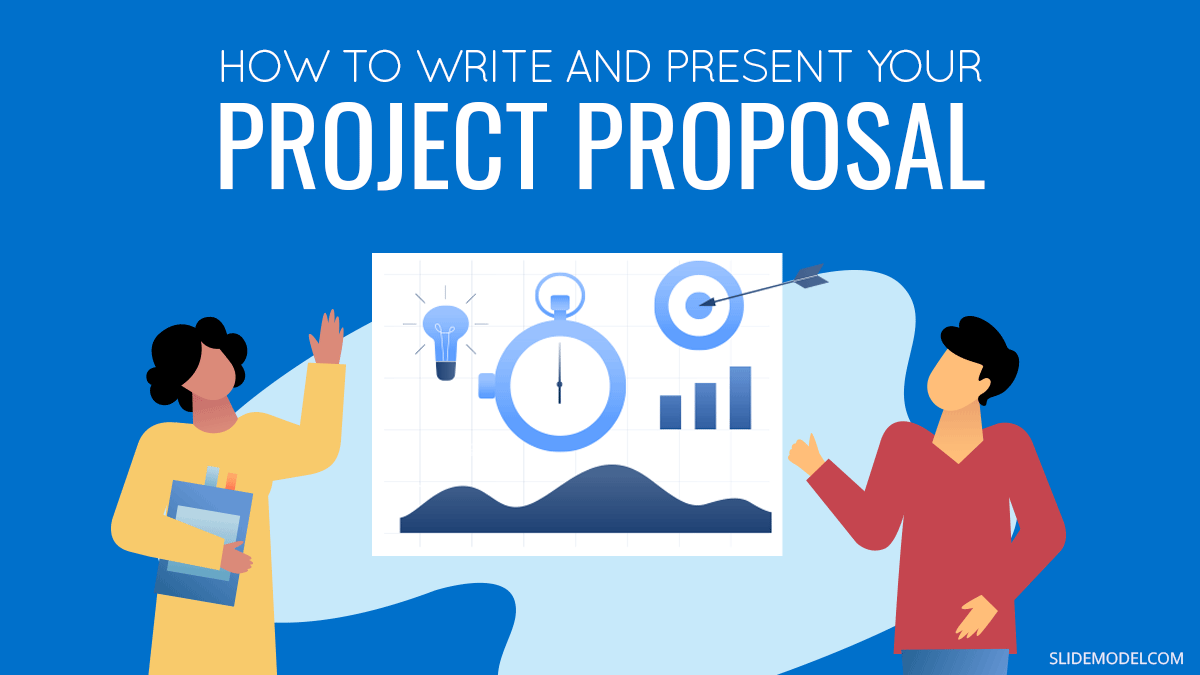
Every manager or executive has at some point of their career the need to create a project proposal (or initiative, we will use both terms instinctively in this post). In this opportunity we will briefly define the concept, how to write it and more importantly how to present it to an audience. Persuasion is key. Being able to transmit the right message behind the proposal will help you engage your audience with your ideas.
What Is a Project Proposal?
A project proposal is a document that details a new project idea. Its main objective is to communicate the idea, and what is needed to make it happen. In its most basic form, it contains a title, initial and end dates, objectives, goals and the overall main achievement pursued at completion of the project.
Formal project proposals have clear sections that have been proven to effectively communicate a project idea. The basics include context about the problem or pain trying to solve, a high level action plan, and the required resources to execute it. We’ll give you more detail into how to write project proposal categories later on in this article.
Note that a business project proposal is not the same thing as a complete project plan , in terms of project management . The project proposal includes a lot of details in many of the same categories as a project charter or a complete project plan. However, it is not the same document. The project proposal is not a detailed execution plan. There are lots of details that may change between the proposal presentation and the final, approved project plan.
Types of Project Proposals
There are many different kinds of project proposals, since there are many different kinds of projects. For the sake of keeping the article with a reasonable length, we will exemplify Business Project Proposals.
Business project proposals range from formal to informal and vary greatly depending on the industry and company where they are defined. This article focuses on business project proposals, though a lot of the basics and recommendations also apply to different categories.
Situations that Require to Write a Business Project Proposal
Projects intake vary depending on the management frameworks applied by every organization. But there are common management practices that trigger the need for project proposals.
The most common place for project definitions and ideation is during Corporate Planning. Independently of the size of the organization, planning is a practice that every professional organization carries out. Could be defined as Corporate Planning, or just Growth planning, but the time of the year where executives prepare their forecast and plan for the future is the main event where initiatives are defined. In order to evaluate them objectively, project proposals are created. Based on the proposals, the executives decide which projects they will sponsor. With this in mind, it is important that the document is formal, informative, but also persuasive.
How to Write a Project Proposal
The following paragraphs describe the common sections of a professional project proposal document. Keep in mind that this guide does not pretend to be exhaustive and is understood that you’ll need to evaluate adjustments to this outline in order to make it work for your industry, field, and department.
Step One: Define the Purpose around a Problem or Pain
No executive team will approve or fund a project if it’s not solving a realistic problem, situation. While it may sound negative, in business a lot of decisions are made around addressing pains, both organizational and client-facing. This step aims to show stakeholders why your project is important and what are the stakes if they don’t approve it.
Since your problem statement is the very first section of your project proposal, it has to be strong. If you don’t make your audience start believing in the need for a new initiative at this point, it will be very hard to change their minds later on. Don’t exaggerate the problem, since that is easy to discover later on, but be emphatic about why this is a problem that needs fixing. Backup your claims with facts, figures, and business cases. The cost of “ not doing ” is also a strong argument.
Here are some questions to consider when defining the problem:
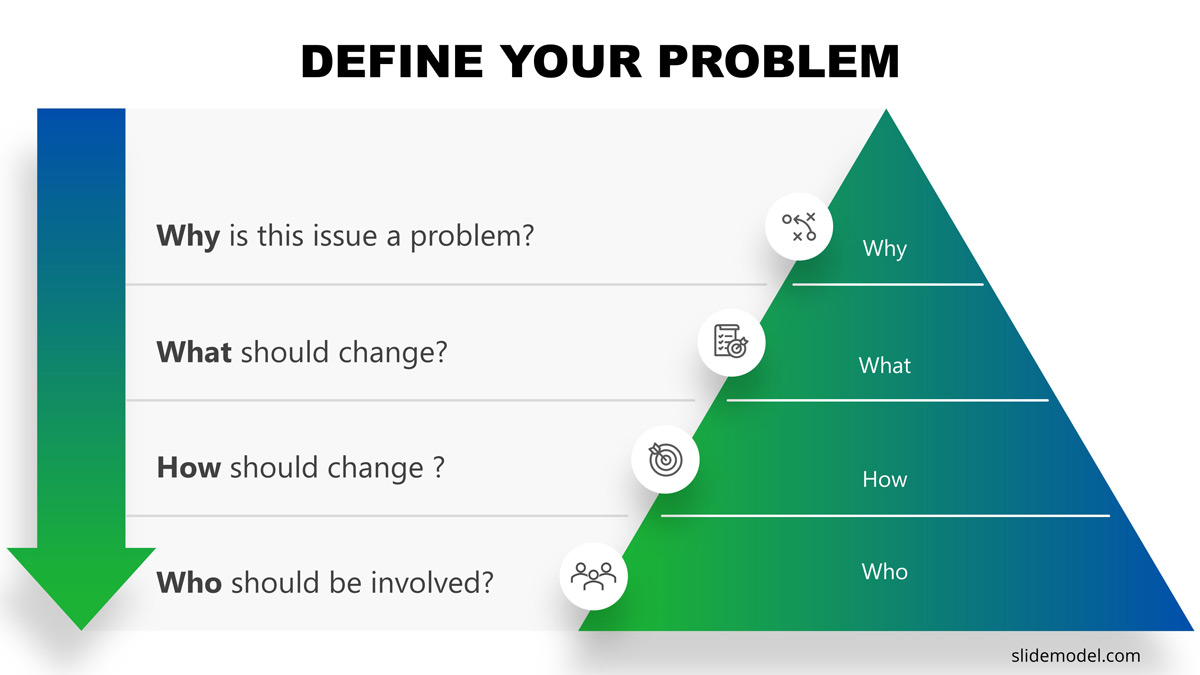
Step Two: Introduce The Solution
Now that you’ve hopefully convinced your audience of the existence of a problem, you now have to introduce the proposed solution. The next several steps will help you specify some of the more tangible components of the “how”. On this step, however, you’re still at the dazzling and inspiring stage.
That means your introduction to the plan should focus on its benefits.
How is this going to address the problem and what is your organization going to get out of it? Think increased profits, lowered costs, new products on the market, more satisfied clients, increased brand awareness, etc.
What is the anticipated impact of your project or idea? Focus on wide-ranging effects for a more impressive presentation.
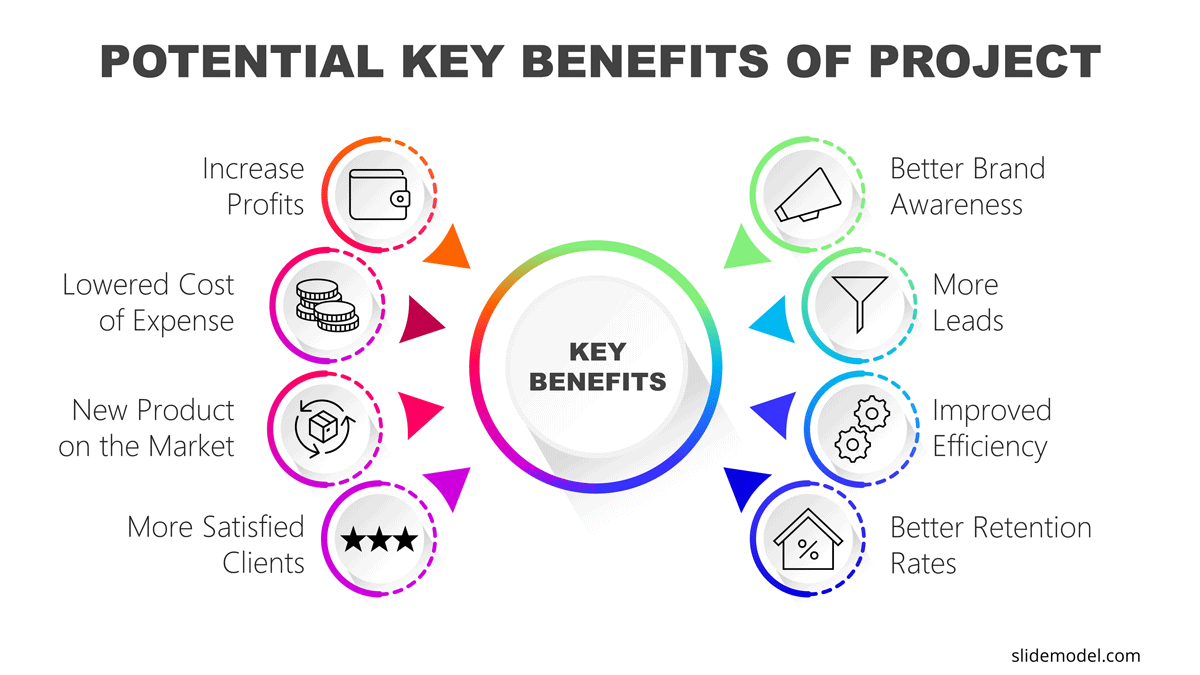
Step Three: Specify Deliverables and Success Criteria
Deliverables are the results of your project. Think about it as the components, both tangible and intangible, that you’ll be delivering. Include the functions and characteristics of each deliverable, such as what it will do, how it will work, and what benefit it will have. Include details such as due date and key tasks required to successfully carry out each deliverable.
Alongside the definition of deliverables are the success criteria. It’s important to specify how you’ll know if each deliverable has been successfully created, as well as the project as a whole. Whenever you’re presenting objectives or criteria for evaluating success, use the SMART goals approach. SMART stands for specific, measurable, achievable, realistic, and time-bound. You can try using a roadmap template to visualize these deliverables and delivery dates.
Step Four: Outline Project Resources
In order to execute a project, you will require resources. Generally in a project proposal you will divide this definition in two. First, an overall estimation of resources in a common language , financial . So you will translate every resource into budgeting terms and define an investment number. Then, you will break down these financials into: assets (i.e.: technology, infrastructure), human resources, services (i.e.: advertisement, consultancy).
Step Five: Outline your Schedule
In this section you will combine deliverables and resources to generate a high level roadmap. Main points to highlight are start and end of the project, delivery dates and resources usage times. In this way you will materialize the proposal in high level activities.
Step Six: Executive Summary
Once the detailed version of your project proposal is complete, it’s time to summarize it into an executive summary. This summary will include a high-level list of each key element of your proposal. The idea of the executive summary is to be able to summarize in one page all the proposal, in a way an executive can grasp the overall scope.
How to Present a Project Proposal to Stakeholders
Your project presentation will follow the basic steps detailed above. Here is a project proposal example structure using project proposal templates to help you get started on your presentation.
Slide 1: Cover Slide with Project Name
Like in all presentations, you don’t dive into the main part of the presentation without introducing the name of the project and yourself as presenter. Covers slides provide some visual stationary previous the presentation kick off. As a recommendation, set a project name that will make it memorable.
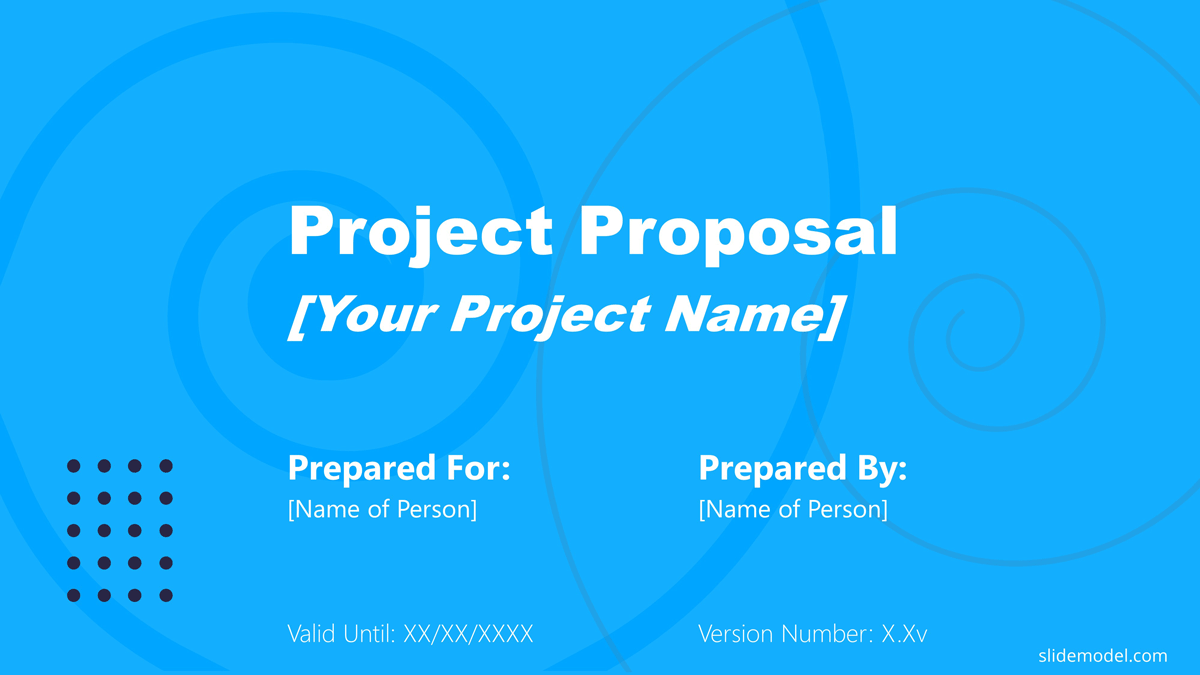
Slide 2: Table of Contents
Audience members will have an easier time paying attention if they know what to expect from your proposal presentation. See the following slide for a common project proposal table of contents format. When presenting it, do not dive into details. The agenda slide is aimed to set a mental state in the audience on the structure of the information will follow. It is a presentation best practice to prepare the audience.
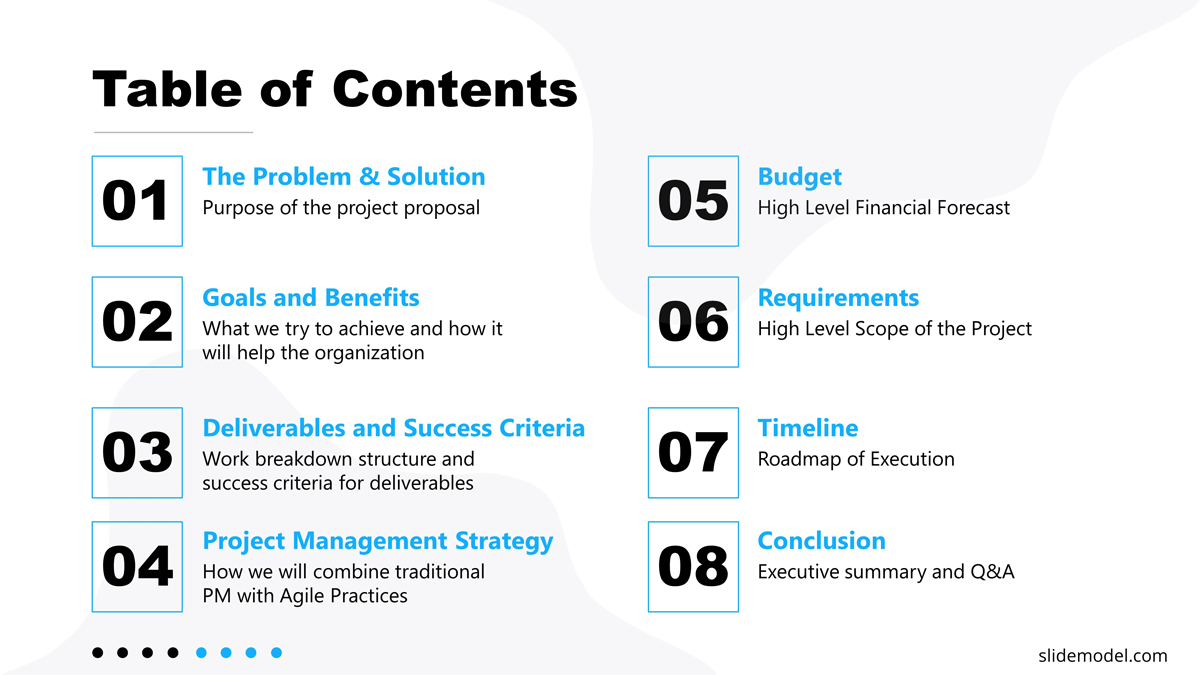
Slide 3: The Problem
Summarize your problem statement in one or two sentences. Be BOLD . When creating this problem summary, make sure to touch upon what the problem is, why it is a problem, how this problem manifests, who this problem affects, and what is the fallout of this problem. Make sure your message is directed to the real pain to solve. Avoid repeating the detailed problem definition; the audience can drill down in the documentation for the facts behind your statements.
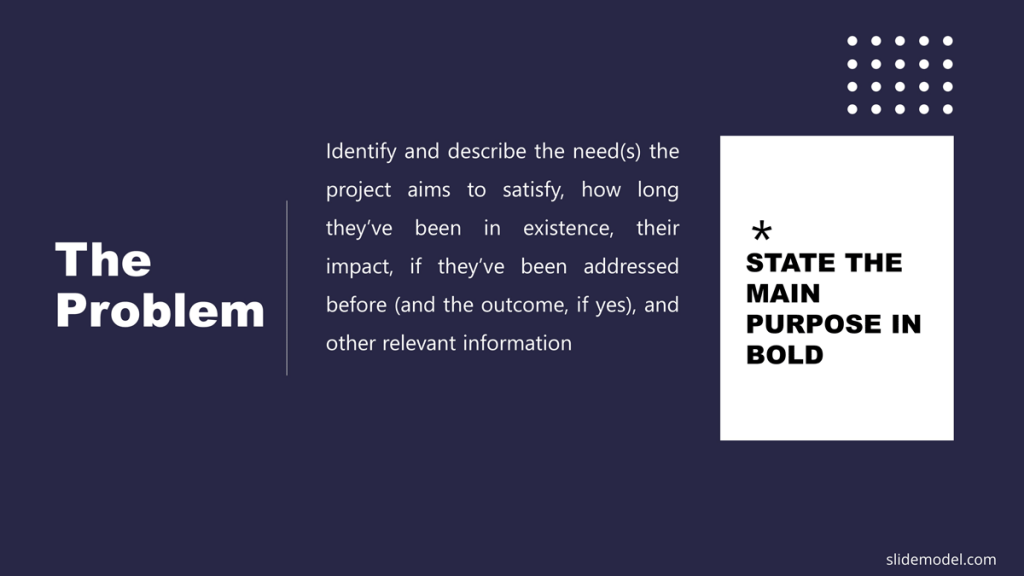
Slide 4: The Solution
As the first slide that formally introduces your projects proposal, this slide should briefly communicate what it is you are proposing to do. You can frame this slide in terms of the solution to the previously mentioned problem or you can introduce it as your plan. Either way, make sure this project introduction is no more than 1-3 sentences long. You’ll have time to specify other details in later slides. At this point of the presentation, your audience curiosity starts to peak, and you need to build your persuasive speech.
Slide 5: Goals and Benefits
For this slide, you want to briefly list the main goals for what you want to achieve with your project, as well as the top benefits your project will generate for the organization. While there may be a much larger list of these two components in your project proposal document, you’ll want to present the most important/relevant here. Try to group goals and benefits into categories. Remember that what you put on your PowerPoint slides is only the tip of the iceberg when it comes to your presentation. You can and should give more details in the spoken part of your proposal presentation.
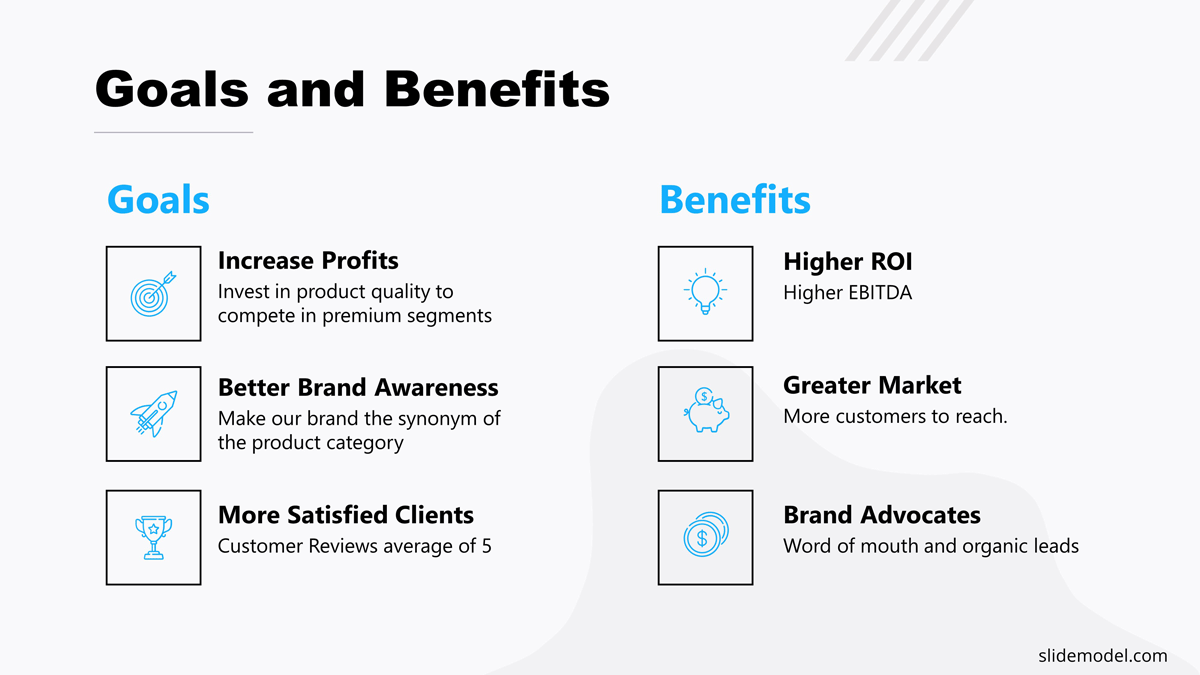
Slide 6: Deliverables and Success Criteria
Without going into too much detail, list deliverables, due dates, and criteria for acceptance for your main deliverables.
Slide 7: Project Management Strategy
State the project management strategy you’re planning to use to manage the project. You can’t assume everyone in your audience will understand what each project management strategy entails, so you should also provide a brief description of your choice. These templates detailing the Scrum , Kanban , and Waterfall methodologies can give you ideas of how to summarize your chosen methodology.
Slide 8: Budget
The budget slide remains pretty simple. Report both the total budget you anticipate for the project as well as a general breakdown of the budget into the main categories. Providing the percentage of each category of the budget is helpful for stakeholders to conceptualize it. In the Project Proposal Presentation template we have included a project budget slide (in slide #9) with a data table that can be used to present the Budget information.
Slide 9: Project Requirements
Other than budget, what’s needed in order to complete your project? Will you need human resources, specific software, equipment, or a special location in order to execute your project? Add a simplified list here of the main requirements.
Slide 10: Project Proposal Timeline
You will not be able to present the entire project timeline in a simple project proposal presentation. However, you should present an overview of the timeline, including major phases and deliverables. Instead of presenting a simple chart with deliverables and dates, we recommend placing your timeline of deliverables and phases in an actual calendar. This puts your timeline in a visual context of quarters, months, or weeks, allowing audience members to have a clearer concept of how long this project will take.
Slide 11: Conclusion
Close your project proposal with a very short summary of the project, similar to what you wrote previously when introducing your solution. The point of this is to remind your audience of the overarching reason for this presentation, especially after going over potentially less-than-inspiring details like budget and requirements.
Slide 12: Thank You Slide
Don’t forget to thank your audience for listening to your project proposal. Add your contact information in case this project proposal is sent over email and reviewed individually.
Final Words
In this article we had reviewed the definition of project proposal, its main structure and a guide on how to present it to your stakeholders. For further reading about presentations skills , here is a guide to improving your public speaking skills that will help you present your project proposal even more effectively. Hope you had enjoyed the reading.
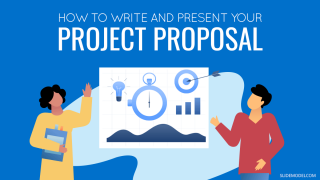
Like this article? Please share
Project Execution, Project Management, Project Planning Filed under Business
Related Articles

Filed under PowerPoint Tutorials • November 8th, 2023
How To Present an Action Plan
An Action Plan is a sequence of steps that must be performed for a strategy to succeed. Learn how to present your Action plan to an Executive Audience.
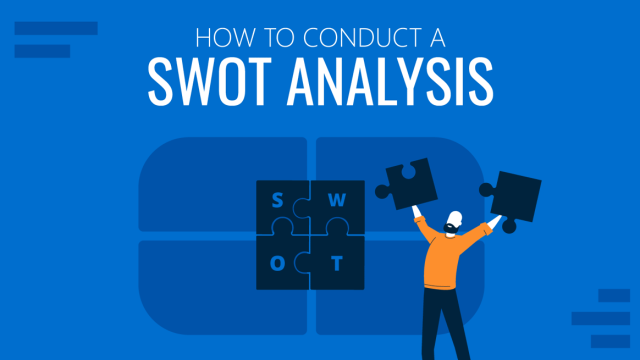
Filed under Business • September 15th, 2023
How to Conduct a SWOT Analysis (Examples + Templates)
Bring value to your business and to potential customers by learning how to conduct a SWOT analysis. Detailed guide with examples + suggested templates.
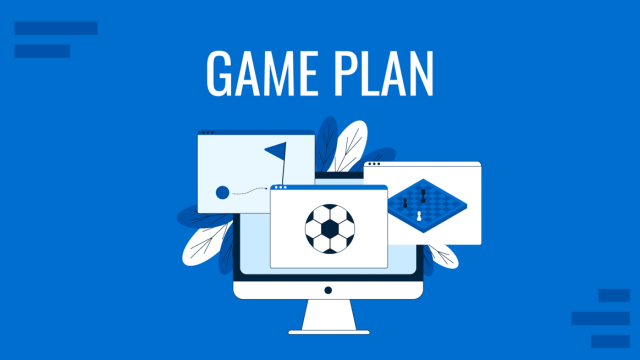
• September 8th, 2023
Game Plan PowerPoint Templates For Sports And Strategic Presentations
Game Plan Templates are an exclusive set of PPT templates that experts have designed to create sports and strategy-related presentations.
Leave a Reply
- PowerPoint Themes
- Latest PowerPoint Templates
- Best PowerPoint Templates
- Free PowerPoint Templates
- Simple PowerPoint Templates
- PowerPoint Backgrounds
- Project Charter
- Project Timeline
- Project Team
- Project Status
- Market Analysis
- Marketing Funnel
- Market Segmentation
- Target Customer
- Marketing Mix
- Digital Marketing Strategy
- Resource Planning
- Recruitment
- Employee Onboarding
- Company Profile
- Mission Vision
- Meet The Team
- Problem & Solution
- Business Model
- Business Case
- Business Strategy
- Business Review
- Leadership Team
- Balance Sheet
- Income Statement
- Cash Flow Statement
- Executive Summary
- 30 60 90 Day Plan
- SWOT Analysis
- Flow Charts
- Gantt Charts
- Text Tables
- Infographics
- Google Slides Templates
- Presentation Services
- Ask Us To Make Slides
- Data Visualization Services
- Business Presentation Tips
- PowerPoint Tutorials
- Google Slides Tutorials
- Presentation Resources

How To Write A Project Proposal Presentation?
A project proposal is an initial step towards starting any project. Every manager or executive has to write a project proposal at some point. Every project proposal is planned and outlined strategically. This blog will help you to make an impactful project proposal presentation that leaves a lasting impression.
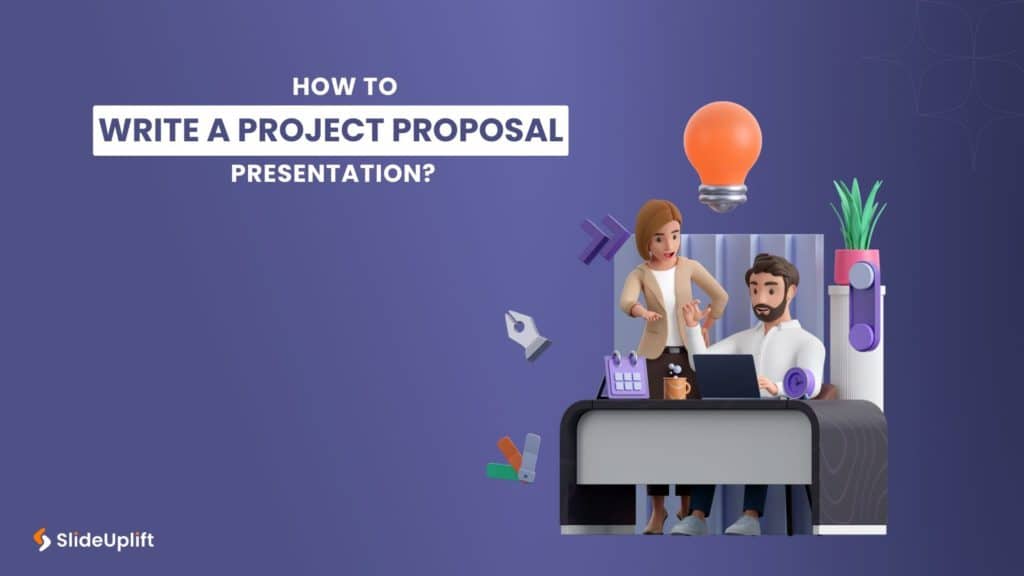
Presenting your ideas well is essential to gaining quick approval for projects, whether internal or external. Even the strongest elevator pitch is not going to work by itself. Writing a project proposal presentation enters the picture at this point. You must be able to deliver a proposal for a project effectively if you have the technology or product to show a particular investor. This blog will help you understand how to write a project proposal presentation quickly and how to compose it.
What is a Project Proposal Presentation?
A project proposal serves as a project management tool for outlining the goals and specifications of a project. It facilitates initial project planning framework agreement between organizations and external project stakeholders.
Its primary goal is to win over decision-makers. Because of this, a project proposal presents the main selling point of your endeavor to internal and external project stakeholders. The proposal aims to catch the interest of project sponsors and stakeholders.
Different Types of Project Proposal Presentations
Before learning how to make a project proposal presentation, you need to know that they are of different types. Here are some of the types in which you can give a presentation of a project proposal:

1. Solicited Project Proposal:
A solicited project proposal is a formal document submitted in response to a specific request or invitation from an organization or entity seeking external project ideas or services. The one requesting issues a Request for Proposal (RFP).
The proponents create a solicited project proposal presentation detailing their approach, expertise, timelines, and costs for addressing the outlined needs. Organizations evaluate and compare the proposals that describe their solutions and services before selecting them.
2. Unsolicited Project Proposal
In an unsolicited proposal, you create a proposal after carefully identifying the possible solutions for the problems. It’s unlike an RFP but something an investor didn’t ask for. These project proposal presentations are sent to potential clients without being asked for as a pitch or an introduction to investors or sponsors.
3. Informal Project Proposal
With informal project proposals, potential customers express interest in your offerings and ask to review your proposal. Since these are based on conversations rather than official requests, they frequently include all the required information. So they usually need much more research.
4. Renewal Project Proposal
A renewal project proposal presentation is a document that outlines plans for extending, updating, or continuing an existing project or service. These offers are made to potential customers to prolong the support for an ongoing project close to completion. The proposal typically includes reviewing the project’s past performance, achievements, and any necessary adjustments or enhancements for the renewal period.
5. Continuation Project Proposal
A continuation project proposal is a document submitted to request for extension or continuation of an existing project beyond its initially planned time frame. It typically includes an assessment of the project’s progress, achievements, and the need for additional time to accomplish its goals. The proposal outlines the reasons for the extension, any adjustments to the project plan, and a renewed timeline to ensure the successful completion of the ongoing initiative.
6. Supplemental Project Proposal
A supplemental project proposal presentation is a formal request document submitted to propose additional work or modifications to an existing project. The use of this proposal arises due to changing project requirements, unforeseen challenges, or the identification of new opportunities during the project. The proposal details the scope of the supplemental work, its impact on the overall project, associated costs, and any adjustments needed in the project plan.
This section gives you some clarity on how to write a project proposal PowerPoint presentation. It outlines the blueprint of a comprehensive presentation, using a project proposal presentation example:

1. Understand Your Audience and the Problem you’re Solving:
Before diving into the content creation process, it’s essential to have a deep understanding of your audience. Identify their needs, concerns, and expectations to tailor your project proposal presentation accordingly. This ensures that your proposal addresses their specific requirements and resonates with them.
Persuade your reader with references and data. Among the inquiries to make are:
- What issue is your project trying to solve?
- What is known about this issue already?
- Who has previously tackled this issue, and what literature is available?
- Why can’t this problem be adequately addressed by previous research?
2. Define Clear Objectives:
Clearly outline the objectives of your project proposal presentation on PowerPoint or Google Slides . Whether seeking approval, securing funding, or gaining support, having well-defined goals will guide your content creation process and help you focus on delivering a persuasive message.
A few things to mention are:
- Your project’s mission statement
- Your project timeline, complete with significant checkpoints
- Roles and duties of the project team
- A risk register outlining your risk-reduction strategy
- Deliverables for the project
- Tools for reporting that you’ll utilize during the project
3. Structure Your Presentation:
Create a well-organized structure for your presentation to maintain clarity and flow. Begin with an engaging introduction, followed by a detailed overview of the project, the problem it aims to solve, proposed solutions, and a compelling conclusion. Use visual aids, such as slides and graphics, to enhance understanding and engagement.
As you’re defining the structure of your presentation, be sure to incorporate the following:
- The outcome or goal of your undertaking
- A schedule for the project’s deliverables’ readiness
- SMART objectives in line with the outputs you’re generating

4. Craft a Captivating Introduction:
Start your project proposal presentation with a hook that captures attention and sets the tone for the rest of the proposal. Clearly state the problem your project addresses and why it’s important. Establish a connection with your audience by highlighting the project’s relevance to their interests or goals.
5. Clearly Define The Project Scope:
Provide a comprehensive overview of your project, detailing its scope, objectives, and anticipated outcomes. Clearly articulate the timeline , milestones , and deliverables to give your audience a realistic understanding of what to expect.
6. Highlight The Value Proposition:
Emphasize the unique selling points and benefits of your project. Communicate how it addresses the identified problem and why it stands out from alternative solutions. Use data, testimonials, or case studies to bolster your claims and build credibility.
7. Develop A Realistic Budget:
Include a detailed budget that outlines the financial requirements of your project. Break down costs into categories and provide justifications for each expense. This demonstrates a thorough understanding of the financial implications and reinforces your credibility.
8. Address Potential Challenges And Risks:
Acknowledge potential challenges and risks associated with the project and outline mitigation strategies. Demonstrating a proactive approach to risk management reflects your preparedness and commitment to the project’s success.
9. Engage Your Audience:
Encourage audience interaction throughout your presentation. Incorporate opportunities for questions and discussions to address concerns, gather feedback, and foster a collaborative atmosphere.
10. Conclude with a Strong Call to Action:
Wrap up your presentation with a compelling conclusion reinforcing the project’s value and importance. Clearly state the desired action or decision you seek from your audience, whether it’s approval, support, or funding.
By following these comprehensive steps, you can create a project proposal presentation that informs and persuades, increasing the likelihood of successful project approval and implementation.

How To Present A Project Proposal Presentation?

Presenting a project proposal is an art that involves not just the spoken word but also the visual representation of your ideas. Each slide in your presentation plays a crucial role in conveying key information and building a compelling case for your project:
Slide 1: Title Slide
The title slide sets the tone for your presentation. Include the project title, your name or team name, and the date. Use visually appealing graphics or images related to the project to capture attention.
Slide 2: Agenda
Provide an overview of the presentation structure . This helps orient your audience and gives them a roadmap of what to expect. Clearly outline the key topics and sections you’ll be covering.
Slide 3: Introduction
Start with a compelling introduction. Highlight the problem your project addresses and why it is significant. Engage your audience initially, making them eager to learn more about your proposal.
Slide 4: Project Overview
Offer a brief but comprehensive overview of the project. Include key details such as the project’s purpose, goals, and objectives. Use visuals like charts or graphics to convey information succinctly.
Slides 5-8: Problem Statement and Need
Dedicate a few slides to articulate clearly the problem your project aims to solve. Provide data, statistics, or real-life examples to emphasize the urgency and relevance of the issue.
Slide 9: Solution
Present your proposed solution to the identified problem. Break it into key components and use visuals to illustrate how your project addresses the issues. Communicate the unique value of your solution.
Slides 10-12: Project Scope and Deliverables
Detail the scope of your project , including specific deliverables and milestones. Use visuals like timelines or Gantt charts to help your audience visualize the project’s timeline and workflow.
Slide 13: Budget
Introduce the financial aspect of your project. Break down the project budget into categories and provide a clear overview of the costs associated with each. Use graphs or pie charts to make the information easily digestible.
Slides 14-15: Risks and Mitigation
Acknowledge potential challenges and risks associated with your project . Demonstrate your awareness and preparedness by outlining mitigation strategies for each identified risk.
Slide 16: Team and Expertise
Introduce the key members of your project team and highlight their relevant expertise. This slide helps build credibility and assures your audience that you have the necessary skills to execute the project successfully.
Slide 17: Conclusion and Call to Action
Wrap up your presentation with a powerful conclusion. Reiterate the key points, emphasize the project’s value, and issue a clear call to action, whether it’s approval, support, or further discussion.
Tips On Giving A Project Proposal Presentation
Regardless of the type of presentation you deliver, your goal is to influence or wow the audience:
Define Your Agenda:
- Clarify proposal details for investors and clients.
- Address omitted RFP questions.
- Contrast your plan with rivals if requested.
Tell a Story:
- Introduce data, charts , and graphs with a narrative.
- Engage the audience by appealing to human nature.
- Enhance content through storytelling.
Think Lean:
- Apply lean thinking to enhance client relationships.
- Eliminate non-beneficial procedures in your presentation.
- Avoid jumping to long-term future estimates.
Construct an Eye-Catching Presentation:
- First, dress appropriately for the presentation you are about to give.
- A well-constructed presentation reflects positively on your company.
- Avoid hastily put-together presentations to maintain quality perception.
Ask Questions:
- Avoid excessive talking during the presentation.
- Engage the audience by posing questions.
- Boost your confidence and gather feedback through polls or direct inquiries.
ALSO READ: How to write an effective project charter?
Top 5 Project Proposal Templates
1. project proposal summary powerpoint template.

This template provides a concise and visually appealing overview of your project proposal, featuring key elements such as objectives, timelines, and budgetary considerations in a structured and professional format.
2. Project Proposal Presentation Template

The Project Proposal Presentation Template is designed for project leaders to propose new ideas to clients, investors, or business owners. Executives can also use it to propose their businesses to different investors. The marketing, product, and project management teams can use this presentation to propose new business or project ideas.
3. Project Management Lifecycle PowerPoint Template

Specifically designed to illustrate the phases and milestones of project management, this template guides stakeholders through the entire project lifecycle, emphasizing key stages, deliverables, and decision points for a comprehensive understanding.
4. Project Management Swimlane PowerPoint Template

This template employs a swimlane format to delineate responsibilities among team members or departments, offering a clear and organized visualization of tasks and workflows to enhance transparency and streamline project execution.
5. Business Proposal Deck PowerPoint Template

A sophisticated and customizable template for crafting compelling business proposals , this deck incorporates modern design elements to showcase essential details, including market analysis, value propositions, and financial projections, ensuring a professional and persuasive presentation.
Developing a project proposal is essential for connecting you, your group or organization, investors, and other stakeholders. Your greatest option for a concise, educational, and polished presentation is a project proposal presentation. As discussed above, making an eye-catching summary of your project will attract more interested outside collaborators and their encouraging comments.
You can also access SlideUpLift, one of the top platforms for presentation templates and tools to help with the presentation-making task. You can select from a wide range of carefully crafted templates for project proposals. SlideUpLift gives presenters the tools to make visually striking and memorable presentations, emphasizing customization, clarity, and aesthetics.
How do I make a project proposal PowerPoint presentation?
To create a project proposal PowerPoint presentation, start by outlining the project’s goals, objectives, and key details. Utilize SlideUpLift’s Project Proposal templates for a professional look and incorporate visuals for clarity.
What is the step-by-step process for the presentation of a project proposal?
During the project proposal presentation, the presenter should introduce the project, present an overview, detail the methodology, present the timeline and budget, and conclude with a summary of key points.
What should I include in the presentation of a project proposal?
In a project proposal presentation, you should cover essential elements such as project goals, methodology, budget, and team details to provide a comprehensive overview for stakeholders.
How should I start a project proposal presentation?
Begin your project proposal presentation with a strong opening, clearly introducing the project’s name and purpose and highlighting its significance to capture the audience’s attention.
Where to find the best Project Proposal Presentation templates?
There are a variety of project proposal presentation templates available on SlideUpLift. Just find your desired template on SlideUpLift.com and download it.
Table Of Content
Related presentations.

Animated Business Proposal PowerPoint Template

Project Scope Summary PowerPoint Template

Marketing Proposal PowerPoint Template
Related blogs.

10 Best Business PowerPoint Templates for Presentations

10 Best Business Presentation Topics to Captivate Your Audience

10 Best Google Slides Templates And Themes For Presentations

10 Best PowerPoint Templates for Finance Presentations
Tags and categories, privacy overview.
Necessary cookies are absolutely essential for the website to function properly. This category only includes cookies that ensures basic functionalities and security features of the website. These cookies do not store any personal information
Any cookies that may not be particularly necessary for the website to function and is used specifically to collect user personal data via ads, other embedded contents are termed as non-necessary cookies. It is mandatory to procure user consent prior to running these cookies on your website.
- Google Slides Presentation Design
- Pitch Deck Design
- Powerpoint Redesign
- Other Design Services

- Business Slides
- Guide & How to's
How to make presentation for project proposal
To create a project proposal presentation, you need to elaborate your project proposal first. Proposing an idea of sales increase or company development direction to your management or CEO is similar to pitching your startup. If you have some product or technology to present to a specific investor, you need to know how to make a presentation for a project proposal.
One way is to contact a professional presentation agency that will design and put your content into an attractive shape. Another way is to read our article and highlight valuable points to incorporate in your presentation.
Your presentation slides must include information about:
- Problem description;
- Path to take;
- Objectives and Goals;
- Your team preferences;
- Your project’s worth;
- Start and end dates.
Project proposal sections to include in the initial document:
- Executive summary;
- Project background;
- Solutions and approach;
- Financial information;
- Additional documents;
- Conclusion.
If you wonder what to say at a project proposal conclusion presentation, read the next section with tips to nail your piece of art.
Tips on Giving Project Proposal Presentation PPT
No matter what kind of presentation you do, you want to impress or impact the audience. Consider these recommendations if you wonder how to make a project proposal PowerPoint presentation:
1. Know Your Audience
Who is your audience? What industry do they work in? What positions do they generally hold? Your audience will expect to find out more about the internal and external peculiarities of the project. Make sure you have these slides and information with associated objectives, requirements, risks, constraints, etc.
2. Use Structure to Build on Ideas
Your content cannot be tossed around randomly. Each preceding slide must explain the current one, and every next slide must expand the previous one logically. No sense – no understanding – no approval – no funding – no sales – no success. If you dislike this chain, make sure each presentation section builds on the one before it.
3. Use Visuals
Charts, graphs, and infographics communicate the profitability and feasibility of your project proposal at best. The majority of people are visual learners, so neglecting this approach is decreasing the impact you could cause. Besides, choose a design for the project proposal presentation. If you lack proficiency, we recommend contacting pitch deck services to have a top-notch design.
4. More Repetition – More Recognition
The first checkpoint is: do you understand what you are talking about? If not, your audience will neither. Keeping up the presentation flow is only possible when you realize your topic from all sides. Moreover, repetition is useful for your audience as well: encourage people to remember key points.
5. Give a Brief Rundown
What is it that you wanted to tell? Give a brief rundown of key points, move to the presentation body, tell in detail what was highlighted in the beginning, and go to the end again. It reinforces the main points and creates a complete picture in mind. Some people may forget the introduction if the presentation is long, so help them to reminisce all important statements.
In summary, the project proposal is an important document for relationships between you, your company, or team, and stakeholders like investors. Project proposal presentation is your best choice to be short, informative, and professional. Such an attractive overview of your project will bring more engaged outside contributors and their positive feedback.
- Presenting techniques
- 50 tips on how to improve PowerPoint presentations in 2022-2023 [Updated]
- Keynote VS PowerPoint
- Types of presentations
- Present financial information visually in PowerPoint to drive results

- Design Tips
Top strategies and tips for creating awesome marketing presentations

The ultimate guide to creating an ideal elevator pitch presentation in 2023

Introduce a new product idea in a presentation
6 Tips for Your Next Proposal Presentation
Shortlisted after submitting a proposal? Use these tips to create an effective proposal presentation and better align sales and proposal teams.

Proposal generation is often a key role in sales enablement. Frequently, after a proposal is submitted, the RFP issuer invites shortlisted bidders to present their proposal on-site. As a result, proposal teams and sales must work together to create a high-quality proposal presentation.
Proposal presentations are critical. This is an opportunity to address questions that the selection panel has. Additionally, the selection panel may compare your presentation to your competitors to sift out who is more technically competent.
No matter the purpose, proposal presentations require proposal teams and sales to align. Here are 6 tips for your next proposal presentation:
1. Define Your Agenda
Prospective clients and investors frequently ask for a presentation post-proposal submissions. Most often, they need to gain a better understanding of the proposal. Sometimes, they want information clarified. Other times, there was a question left out of the RFP that they now need to be answered. And, sometimes, they want to compare your proposed plan against that of a competitor’s.
In other words: Your audience has an agenda. So should you!
Define your agenda before constructing your proposal . The order of presentation slides should easily unfold once an agenda is defined — no matter if the goal is to offer an opportunity or to solve a challenge. Be clear about the presentation’s agenda during delivery. It’s helpful to include an agenda slide that entails:
- Introductions
- Company history
- Defining the proposed plan
- Spelling out benefits
- Opportunity for questions
2. Start with a Story
What’s more compelling: A story? Or slide after slide of data? “While clients value data, they are also realistic about what data can – and cannot – tell them,” states John Hall of HubSpot , “They’ve seen many projects fail despite the glowing research results and they’ve seen projects succeed despite the lack of any data to back it up.”
Introduce the slides of data, charts, and graphs with a story. Storytelling has a positive impact on content. In fact, the human brain reacts considerably different when presented with facts versus stories. By sheer human nature, leading with a story will cause the selection panel to be more interested in the contents of your proposal presentation.
3. Think Lean
Lean thinking improves interactions with clients. Lean is commonly applied as a model for manufacturing systems . Lean thinkers drive value by eliminating practices that don’t add value to customers. Forbes contributor, Hakan Ener, suggests applying lean thinking to your proposal presentation. Avoid simply jumping to long-term projections of the future.
When speaking with potential business investors, clients, or partners, only ask for the resources that will cover the next phase of your action plan. Ask yourself if your presentation talking points provide immediate value.
4. Create a Gleaming Presentation
A proposal presentation is similar to a job interview. If you’re supposed to dress for the job you want, your presentation should be dressed for the business you want to win.
A poorly designed proposal presentation can detract from your talking points. A proposal presentation that is haphazardly thrown together could be perceived as indicative of poor quality to your business offering as well. Some of Small Business’ general best practices in presentation design include:
- Limiting ideas to one per slide
- Using a large font size
- Keeping a consistent, subtle background
- Ordering slides to the defined agenda
- Presenting easy-to-read charts, graphs, and tables
Lost on where to start in design? Check out these tips and tools that can help you create a killer presentation.

5. Ask Questions
A proposal presentation doesn’t mean you should talk, talk, talk. In fact, too much talking can do damage to your proposal. A few minutes into the start of the presentation, pause and ask the selection panel or client a question.
A Stanford GSB lecturer and public speaking expert, Matt Abrahams, outlines two primary purposes of asking your audience questions :
- Questions connect with the audience.
- Questions build your confidence.
For example, you can ask polling questions: Does this align with your needs?
6. Provide Handouts
Printed presentations help guide the selection panel. They can follow along, write notes, and bring home the information presented — including data, charts, graphs, and tables. Other beneficial handouts include supporting marketing collateral or sales literature in addition to the proposal itself. These handouts should contain compelling content and graphics that effectively reinforce your points.
Yet another benefit, printed materials solidify your proposed plan. Handouts can further define any resources needed or associated costs. Be sure that handout information doesn’t contradict with what’s in the already submitted proposal.
- twitter Tweet
- facebook Share
- pinterest Pin
Mimeo Marketing Team
Mimeo is a global online print provider with a mission to give customers back their time. By combining front and back-end technology with a lean production model, Mimeo is the only company in the industry to guarantee your late-night print order will be produced, shipped, and delivered by 8 am the next morning. For more information, visit mimeo.com and see how Mimeo’s solutions can help you save time today.
Schedule a Print Consultation Today!
A representative will be in touch with you in the next 24 hours. See how much you can save.
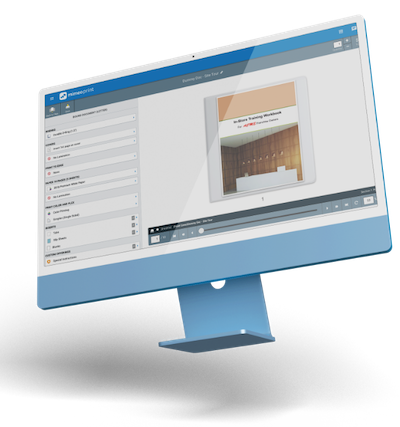
Search Perspectives

- Finance and Real Estate
- Human Resources
- Marketing and Sales
- Operations and Supply Chain
- Proposal Teams
- Retail and Hospitality
- Small Business
- Training Firms Consultants, Associations
- Document Printing
- Wholesale Printing
- Warehousing Fulfilment
- Direct Mail Services
- Promotional Products
- Mimeo Print
- Mimeo Marketplace
- Mimeo Digital
- Training and Consultants
- Manufacturing
- Restaurant and Hospitality
- Medical Equipment
- Associations
- Construction
- Oil and Gas
- Pharmaceutical
- Real Estate
- Presentations
- Newsletters
- Business Cards
- Display Signage
- Kitting and Bundling
- Marketing Folders
- Posters and Banners
- News and Perspectives
- Mimeo Schools
- Mimeo Photos
- Mimeo Business
- Proven Process
- Case Studies
Select your platform to login.
- Contact sales
Start free trial
How to Write a Project Proposal (Examples & Template Included)

Table of Contents
What is a project proposal, types of project proposals, project proposal vs. project charter, project proposal vs. business case, project proposal vs. project plan, project proposal outline, how to write a project proposal, project proposal example, project proposal tips.
- ProjectManager & Project Proposals
A project proposal is a project management document that’s used to define the objectives and requirements of a project. It helps organizations and external project stakeholders agree on an initial project planning framework.
The main purpose of a project proposal is to get buy-in from decision-makers. That’s why a project proposal outlines your project’s core value proposition; it sells value to both internal and external project stakeholders. The intent of the proposal is to grab the attention of stakeholders and project sponsors. Then, the next step is getting them excited about the project summary.
Getting into the heads of the audience for which you’re writing the project proposal is vital: you need to think like the project’s stakeholders to deliver a proposal that meets their needs.
We’ve created a free project proposal template for Word to help structure documents, so you don’t have to remember the process each time.

Get your free
Project Proposal Template
Use this free Project Proposal Template for Word to manage your projects better.
In terms of types of project proposals, you can have one that’s formally solicited, informally solicited or a combination. There can also be renewal and supplemental proposals. Here’s a brief description of each of them.
- Solicited project proposal: This is sent as a response to a request for proposal (RFP) . Here, you’ll need to adhere to the RFP guidelines of the project owner.
- Unsolicited project proposal: You can send project proposals without having received a request for a proposal. This can happen in open bids for construction projects , where a project owner receives unsolicited project proposals from many contractors.
- Informal project proposal: This type of project proposal is created when a client asks for an informal proposal without an RFP.
- Renewal project proposal: You can use a renewal project proposal when you’re reaching out to past customers. The advantage is that you can highlight past positive results and future benefits.
- Continuation project proposal: A continuation project proposal is sent to investors and stakeholders to communicate project progress.
- Supplemental project proposal: This proposal is sent to investors to ask for additional resources during the project execution phase.
A project proposal is a detailed project document that’s used to convince the project sponsor that the project being proposed is worth the time, money and effort to deliver it. This is done by showing how the project will address a business problem or opportunity. It also outlines the work that will be done and how it will be done.
A project charter can seem like the same thing as a project proposal as it also defines the project in a document. It identifies the project objectives, scope, goals, stakeholders and team. But it’s done after the project has been agreed upon by all stakeholders and the project has been accepted. The project charter authorizes the project and documents its requirements to meet stakeholders’ needs.
A business case is used to explain why the proposed project is justified. It shows that the project is worth the investment of time and money. It’s more commonly used in larger companies in the decision-making process when prioritizing one project over another.
The business case answers the questions: what is the project, why should it be taken up, who will be involved and how much will it cost? It’s therefore related to a project proposal, but the project proposal comes before the business case and is usually part of the larger proposal.
Again, the project proposal and the project plan in this case are very similar documents. It’s understandable that there would be some confusion between these two project terms. They both show how the project will be run and what the results will be. However, they’re not the same.
The project proposal is a document that aims to get a project approved and funded. It’s used to convince stakeholders of the viability of the project and their investment. The project plan, on the other hand, is made during the planning phase of the project, once it’s been approved. It’s a detailed outline of how the project will be implemented, including schedule, budget, resources and more.
All the elements in the above project proposal outline are present in our template. This free project proposal template for Word will provide you with everything you need to write an excellent project proposal. It will help you with the executive summary, project process, deliverables, costs—even terms and conditions. Download your free template today.

There are several key operational and strategic questions to consider, including:
- Executive summary: This is the elevator pitch that outlines the project being proposed and why it makes business sense. While it also touches on the information that’ll follow in the project proposal, the executive summary should be brief and to the point.
- Project background: This is another short part of the proposal, usually only one page, which explains the problem you’ll solve or the opportunity you’re taking advantage of with the proposed project. Also, provide a short history of the business to put the company in context to the project and why it’s a good fit.
- Project vision & success criteria: State the goal of the project and how it aligns with the goals of the company. Be specific. Also, note the metrics used to measure the success of the project.
- Potential risks and mitigation strategies: There are always risks. Detail them here and what strategies you’ll employ to mitigate any negative impact as well as take advantage of any positive risk.
- Project scope & deliverables: Define the project scope, which is all the work that has to be done and how it will be done. Also, detail the various deliverables that the project will have.
- Set SMART goals: When setting goals, be SMART. That’s an acronym for specific, measurable, achievable, relevant and time-bound. All your goals would be defined by those five things.
- Project approach: Define the approach you’ll use for the contract. There are several different types of contracts used in construction , for example, such as lump sum, cost plus, time and materials, etc. This is also a good place to describe the delivery method you’ll use.
- Expected benefits: Outline the benefits that will come from the successful completion of the project.
- Project resource requirements: List the resources, such as labor, materials, equipment, etc., that you’ll need to execute the project if approved.
- Project costs & budget: Detail all the costs, including resources, that’ll be required to complete the project and set up a budget to show how those costs will be spent over the course of the project.
- Project timeline: Lay out the project timeline , which shows the project from start to finish, including the duration of each phase and the tasks within it, milestones, etc.
In addition to these elements, it’s advisable to use a cover letter, which is a one-page document that helps you introduce your project proposal and grab the attention of potential clients and stakeholders.
To make the best proposal possible, you’ll want to be thorough and hit on all the points we’ve listed above. Here’s a step-by-step guide to writing a persuasive priority proposal.
1. Write an Executive Summary
The executive summary provides a quick overview of the main elements of your project proposal, such as your project background, project objectives and project deliverables, among other things. The goal is to capture the attention of your audience and get them excited about the project you’re proposing. It’s essentially the “elevator pitch” for the project life cycle. It should be short and to the point.
The executive summary should be descriptive and paint a picture of what project success looks like for the client. Most importantly, it should motivate the project client; after all, the goal is getting them to sign on the dotted line to get the project moving!
2. Provide a Project Background
The project background is a one-page section of your project proposal that explains the problem that your project will solve. You should explain when this issue started, its current state and how your project will be the ideal solution.
- Historic data: The history section outlines previously successful projects and those that could have run more smoothly. By doing so, this section establishes precedents and how the next project can be more effective using information from previous projects.
- Solution: The solution section addresses how your project will solve the client’s problem. Accordingly, this section includes any project management techniques , skills and procedures your team will use to work efficiently.
3. Establish a Project Vision & Success Criteria
You’ll need to define your project vision. This is best done with a vision statement, which acts as the north star for your project. It’s not specific as much as it’s a way to describe the impact your company plans to make with the project.
It’s also important to set up success criteria to show that the project is in fact doing what it’s proposed to do. Three obvious project success criteria are the triple constraint of cost, scope and time. But you’ll need to set up a way to measure these metrics and respond to them if they’re not meeting your plan.
4. Identify Potential Risks and Mitigation Strategies
To reduce the impact of risk in your project, you need to identify what those risks might be and develop a plan to mitigate them . List all the risks, prioritize them, describe what you’ll do to mitigate or take advantage of them and who on the team is responsible for keeping an eye out for them and resolving them.
5. Define Your Project Scope and Project Deliverables
The project scope refers to all the work that’ll be executed. It defines the work items, work packages and deliverables that’ll be delivered during the execution phase of your project life cycle. It’s important to use a work breakdown structure (WBS) to define your tasks and subtasks and prioritize them.
6. Set SMART Goals for Your Project Proposal
The best mindset when developing goals and objectives for your project proposal is to use the SMART system :
- Specific – Make sure your goals and objectives are clear, concise and specific to the task at hand.
- Measurable – Ensure your goals and objectives are measurable so it’s obvious to see when things are on track and going well, and conversely, when things are off track and issues need to be addressed. Measurable goals make it easy to develop the milestones you’ll use to track the progress of the project and identify a reasonable date for completion and/or closure.
- Attainable – It’s important every project has a “reach” goal. Hitting this goal would mean an outstanding project that extends above and beyond expectations. However, it’s important that the project’s core goal is attainable, so morale stays high and the job gets done with time and resources to spare.
- Relevant – Make sure all of your goals are directly relevant to the project and address the scope within which you’re working.
- Time-Based – Timelines and specific dates should be at the core of all goals and objectives. This helps keep the project on track and ensures all project team members can manage the work that’s ahead of them.
7. Explain What’s Your Project Approach
Your project approach defines the project management methodology , tools and governance for your project. In simple terms, it allows project managers to explain to stakeholders how the project will be planned, executed and controlled successfully.
8. Outline The Expected Benefits of Your Project Proposal
If you want to convince internal stakeholders and external investors, you’ll need to show them the financial benefits that your project could bring to their organization. You can use cost-benefit analysis and projected financial statements to demonstrate why your project is profitable.
9. Identify Project Resource Requirements
Project resources are critical for the execution of your project. The project proposal briefly describes what resources are needed and how they’ll be used. Later, during the planning phase, you’ll need to create a resource management plan that’ll be an important element of your project plan. Project requirements are the items, materials and resources needed for the project. This section should cover both internal and external needs.
10. Estimate Project Costs and Project Budget
All the resources that you’ll need for your project have a price tag. That’s why you need to estimate those costs and create a project budget . The project budget needs to cover all your project expenses, and as a project manager, you’ll need to make sure that you adhere to the budget.
11. Define a Project Timeline
Once you’ve defined your project scope, you’ll need to estimate the duration of each task to create a project timeline. Later during the project planning phase , you’ll need to create a schedule baseline, which estimates the total length of your project. Once the project starts, you’ll compare your actual project schedule to the schedule baseline to monitor progress.
Now let’s explore some project proposal examples to get a better understanding of how a project proposal would work in the real world. For this example, let’s imagine a city that’s about to build a rapid transit system. The city government has the funds to invest but lacks the technical expertise and resources that are needed to build it, so it issues a request for proposal (RFP) document and sends it to potential builders.
Then, the construction companies that are interested in executing this rapid transit project will prepare a project proposal for the city government. Here are some of the key elements they should include.
- Project background: The construction firm will provide an explanation of the challenges that the project presents from a technical perspective, along with historical data from similar projects that have been completed successfully by the company.
- Project vision & success criteria: Write a vision statement and explain how you’ll track the triple constraint to ensure the successful delivery of the project.
- Potential risks and mitigation strategies: List all risks and how they’ll be mitigated, and be sure to prioritize them.
- Project scope & deliverables: The work that’ll be done is outlined in the scope, including all the deliverables that’ll be completed over the life cycle of the project.
- Set SMART goals: Use the SMART technique to define your project goals by whether they’re specific, measurable, achievable, relevant and time-bound.
- Project approach: Define the methodology that the project manager will employ to manage the project. Also, figure out what type of contract will be used to define the project.
- Expected benefits: Show how the project will deliver advantages to the company and define what these benefits are in a quantifiable way.
- Project resource requirements: List all the resources, such as labor, materials, equipment, etc., needed to execute the project.
- Project costs & budget: Estimate the cost of the project and lay that out in a project budget that covers everything from start to finish.
- Project timeline: Outline the project schedule, including phases, milestones and task duration on a visual timeline.
Whatever project proposal you’re working on, there are a few tips that apply as best practices for all. While above we suggested a project proposal template that would have a table of contents, meaning it would be many pages long, the best-case scenario is keeping the proposal to one or two pages max. Remember, you’re trying to win over stakeholders, not bore them.
Speaking of project stakeholders , do the research. You want to address the right ones. There’s no point in doing all the work necessary to write a great proposal only to have it directed to the wrong target audience. Whoever is going to read it, though, should be able to comprehend the proposal. Keep the language simple and direct.
When it comes to writing, get a professional. Even a business document like a project proposal, business case or executive summary will suffer if it’s poorly constructed or has typos. If you don’t want to hire a professional business writer, make sure you get someone on your project team to copy, edit and proof the document. The more eyes on it, the less likely mistakes will make it to the final edition.
While you want to keep the proposal short and sweet, it helps to sweeten the pot by adding customer testimonials to the attachments. Nothing sells a project plan better than a customer base looking for your product or service.
ProjectManager & Project Proposals
ProjectManager allows you to plan proposals within our software. You can update tasks for the project proposal to signify where things stand and what’s left to be done. The columns allow you to organize your proposal by section, creating a work breakdown structure (WBS) of sorts.
When building a project proposal, it’s vital to remember your target audience. Your audience includes those who are excited about the project, and see completion as a gain for their organization. Conversely, others in your audience will see the project as a pain and something to which they aren’t looking forward. To keep both parties satisfied, it’s essential to keep language factual and concise.
Our online kanban boards help you think through that language and collaborate on it effectively with other team members, if necessary. Each card shows the percentage completed so everyone in the project management team is aware of the work done and what’s left to be done.

As you can see from the kanban board above, work has begun on tasks such as product documentation and design. Tasks regarding stakeholder feedback, ideation, market research and more have been completed, and there’s a good start on the engineering drawings, 3D rendering, supply chain sourcing and translation services.
A PDF is then attached to the card, and everyone added to the task receives an email notifying them of the change. This same process can be used throughout the life-cycle of the project to keep the team updated, collaborating, and producing a first-class project proposal. In addition to kanban boards, you can also use other project management tools such as Gantt charts , project dashboards, task lists and project calendars to plan, schedule and track your projects.
Project proposals are just the first step in the project planning process. Once your project is approved, you’ll have to solidify the plan, allocate and manage resources, monitor the project, and finally hand in your deliverables. This process requires a flexible, dynamic and robust project management software package. ProjectManager is online project management software that helps all your team members collaborate and manage this process in real-time. Try our award-winning software with this free 30-day trial .

Deliver your projects on time and under budget
Start planning your projects.
How to Create an Effective Business Proposal Presentation: Top Tips for Success
Creating an engaging business proposal and presenting it in front of your potential clients might sound like a difficult task. Knowing what to focus on, how to organize the meeting and shape your approach shouldn’t stress you out.
With our comprehensive guide, you’ll see how easy it can be to create a winning proposal. We’ll also give you tips on how to build confidence in your presenting skills and nail every public speaking event, be it around your proposal or not.
In this article, we’ll cover the proposal presentation creation process, how to best automate it and give you other tips on how to engage your audience.
Create a great business proposal
Whatever your topic may be, the starting process is the same - research. You need to conduct thorough research into your topic, and your audience as well.
The questions you need answered are:
- What problem are your clients facing?
- What are your client’s goals?
- How would they like you to go about helping them achieve those goals?
- Have your clients ever worked with any of your competitors before?
- How much budget can they allocate for this project?
- When do they expect to see results?
Once you conduct your research, you can start creating a proposal presentation. In order to speed up your proposal creation process, you’ll want to look into automation software.
Better Proposals offers a variety of prewritten proposal templates that you can easily customize to your needs. This means that you won’t have to create your presentation from scratch.

With our beautifully designed templates, you’ll have no problem showing your solution and the benefits you’ll bring to your clients in a way that’s easy to understand for everyone.
How to structure your presentation
Start with a short introduction. The point of your presentation introduction is to ease your clients in by explaining to them that you’ve listened and understood their issues. They will want to hear about your process and how you’ll help them achieve their goals so make sure you’re not talking too much about yourself and your company.
Once you’ve created your introduction, it’s time to focus on your process and timescales . This is the time to go into further detail and explain exactly which steps you’re going to take in order to help your client. However, make sure that you’re keeping it easy to understand.
Your clients won’t have the same technical knowledge as you do, so make sure to explain everything in simple terms. As important as it is to talk about your process, it’s even more important to showcase the benefits.
That’s how you sell your services - by talking about tangle results. If you’re providing website building, explain how it will lead to increased sales and market share.
If you’re working with a team, make sure to explain what each member will be working on a week to week basis.
Once you’ve presented your solution, it’s time to get to the price. If you already know your client’s budget, it will be easy for you to come up with a number. But that’s not all, the way you present your price is also very important.
Make sure you’re not using the word price and try using words like investment and ROI instead. It will make your proposal stand out and won’t cheapen your offer. Moreover, it’s important to present your price as a single number.
If you present a few different tiered price points, it will confuse your clients. They won’t know which package to choose, since they are looking to you to explain which steps are needed in order to help them achieve their goals.
Don’t use your presentation to try and upsell your clients. That should be done once you’ve created a relationship with them and created some results with your solution.
Add a great case study
Once you’ve presented your solution and price, it might be a good idea to quickly present a few case studies. They will show how you helped a client in a similar position before. It will be a good way to win over the audience, especially if you think you’ve lost them after presenting your price.
A third-party’s quote about your company will build your credibility. Furthermore, it gives you the opportunity to present the benefits your clients experienced from working with you, as well as how quickly they reached ROI.

Better Proposals’ templates come with a prewrite structure for case studies. We know what the clients want to see and hear, which is why we make sure to provide a visually pleasing layout.
There is no need to go into detail on how much trouble your client was in before they started working with you. Nor should you talk about the process employed to help them achieve results. In most cases, this will be similar to the process you’ve already presented to the client, so don’t repeat yourself.
Instead, focus on the results. By this we mean:
- The benefits the client experienced since working with you . Explain a few details - do they have more time now, have they managed to focus on other parts of their business and more?
- What short and long term goals did you help them achieve?
- When did they achieve ROI ?
- A quote from the previous client.
Case studies are a powerful strategy that can help you win deals and secure more revenue.
How to end your proposal presentation
After that, make sure to outline the next steps as well as present your guarantee and terms and conditions.
It might sound silly, but including a clear call to action is very important. Since you’ve already created a great proposal presentation, it would be a shame not to state what needs to happen next.
Does your client need to send any materials, do they need to pay the first fee, is there a need for a team meeting?
Whatever needs to be done, lay it out in order to make it easy for everyone to understand.
In the guarantee section, present what you could offer the client if anything goes wrong. A popular example would be to promise a free product or service if you don’t provide them with a finished product in the agreed-upon time frame.
Personalize your proposal for the specific audience
While you’re creating your proposal presentation, you need to keep in mind who your audience is. You need to know their needs, wants, lifestyles and behaviour. However, not only do you need to know your audience, but their audience as well.
Who are they selling their products and services to? Firstly, distinguish between a B2B, B2C and a combination of those two types of companies. After that look for any reports that focus on their industry. If you’re selling medical equipment, find out all you can about hospitals, private clinics and any upcoming trends in the market. In addition, identify your competitors and analyze their technological stack using the technographic data insights .
You need to be able to confidently present your proposal and that confidence will come from the amount of research you conduct.
Analyze the previous efforts your client’s company has made in order to solve the problem. If you could explain to them why it didn’t work, it would further demonstrate your expertise and that you’re the perfect person for the job.
When using Better Proposals, you can make sure you’ll never address your clients by the wrong name. With our custom merge tags , you can name your clients, their company and brand and automatically personalize your proposals.
That way, even if you’re recycling your proposal presentations, you can rest assured knowing you didn’t leave the names of your previous clients.
Send out the proposal before the presentation
It’s a good idea to send out your presentation before the meeting.
There are three reasons for that:
- It will give your clients enough information to think about any questions they might have.
- You can utilize proposal analytics to see exactly what your clients are interested in and shape your approach accordingly.
- If your clients agree to your terms, they can sign them then and there using the digital signature option.
Better Proposals offers a great feature called proposal analytics. They show you when your proposals were opened, by who, if they were forwarded, signed and paid.

You will also receive notifications via email for every action your client takes. Moreover, you’ll know exactly how much time did they spend on each of the chapters.

This type of insight will help you understand which parts of your presentation to focus more on in the meeting. Did your client jump straight to the price or did they read every section? Once you analyze their actions, you’ll have a different perspective on your presentation.

Focus on the problem you’re solving, not your offer
Don’t underestimate the power of benefits and value you can bring to your clients. That’s what they’re most interested in. We know that it’s tempting to focus on your offer and go into great detail about how you’re the best person for the job based on your price, approach, quality of work and more.
As important as that is, make sure your primary focus is on the problem you’re going to solve and the benefits you’ll bring them.
Your clients won’t be that interested in your features and other technical details. They want to hear what their future will look like if they start a business relationship with you. For example, if you’re selling a meal prep kit, it would make more sense to highlight benefits like - freeing up time in your customers' days, offering a variety of meal plans and more.

Talking about the technical aspects of your business would only be interesting to potential investors or employees. That's why it’s important to focus on the value you’re bringing to the client.
Arrive early in a neutral setting
The last tip we have for you is to meet the client in a neutral setting. Most of the time the client will want you to come to their office. Even though you’d want to accommodate your clients, meeting them in their office might be detrimental to your deal.
Their office is a place with a lot of distractions. Anyone can walk in and ask for input on their own work, there are deliveries going on and the phones ringing off the hook. Offices are not known as quiet places and that is why you’d want to move the meeting to a more neutral setting.
Our advice is to choose a hotel lobby. They are usually quiet during the workday, making them the perfect setting for a business meeting.
It’s also important to come early. That way you can choose the perfect table, order a drink (nothing alcoholic though) and relax. If you get nervous about presenting, arriving early will help you set up and focus.
Further tips we have for anyone presenting are:
- Rehearse your presentation in front of your colleagues.
- Plan out your pauses and the points you’ll highlight.
- Make sure to connect with your audience, don’t just look at your materials.
- Think about the possible questions they can ask you in advance so that you can prepare answers.
If you win a deal right after the presentation, you’re already in the right place to celebrate. Once everything is done, you can seal the deal with a drink or two.
The first rule of presentations is - to prepare. The more time and effort you put into your presentation, the more confidence you’ll have in your presenting skills. With our actionable guide, you’ll quickly be able to create a beautifully designed presentation that will help you win the deal.
Make sure you start any proposal presentation with thorough research into your potential clients. You’ll have to know the answers to all your questions about the way you would implement your solution before you start writing the proposal.
If you use Better Proposals, you’ll love how quickly and easily you can create a document that is easy to get through and engaging. Sign up for a free trial today and find out for yourself how much our platform can help you in the proposal process.
Are your sales docs more awkward than small talk?

Every Document Is a Proposal
Whether it's a new employee or a new client, your documents say a lot about your business. If you don't see every document as a proposal, you're missing the point.
Using Word to Create Proposals Makes You Look Fucking Pathetic
Think about the impression you're trying to give off and then ditch Word proposals for good. They make you look pathetic.
8 Best Tips for Business Proposal Presentations [+Examples]
Updated: May 24, 2022
Published: February 16, 2022
Business proposal presentations are the culmination of a long sales process between you and your clients. If you don’t structure it correctly or take the time to craft one with care, you risk losing the client’s buy-in for your solution. So getting it right is essential.

In this article, we’ll look at several ways to improve your business proposal presentation (and pitch) and increase the odds that you’ll walk away with a new customer.

Business Proposal Presentation
A business proposal presentation is a document that outlines a business solution for a customer after a lengthy consultation process. It is presented to the customer in either PDF or PowerPoint format, and can be paired with a contract for immediate signing.
Other formats that may be accepted include Google Docs or Google Slides, but PowerPoint is the industry standard. The presentation is then delivered in person or through a video conferencing tool such as Zoom.
Rarely, if ever, is a business proposal presentation sent to the customer for asynchronous perusal. Rather, it’s presented live in a customer meeting . That will give you the opportunity to sell them even more on the solutions you offer and persuade them to make a decision within a reasonable time frame.

Free Business Proposal Template
Propose your business as the ideal solution using our Free Business Proposal Templates
- Problem summary
- Proposed solution
- Pricing information
- Project timeline
You're all set!
Click this link to access this resource at any time.
If you let the customer review the presentation on their own, it’s likely that they’ll lengthen the sales process and even put off making a decision.
When crafting your proposal presentation, there are a few quick best practices to keep in mind.
- Personalize the presentation . While it’s totally fine to reuse a PowerPoint presentation template , you don’t want to accidentally include another business’ name on the deck. So be sure to go through every slide and personalize it for the customer’s goals and pain points.
- Send a pre-meeting email with an agenda. To prepare your customer for the presentation, it’d be wise to send a pre-meeting email with a quick, scannable sales agenda detailing how the meeting will go. That way, you can set the right expectations and keep you both on track.
- Plan your in-person customer visit. If you’re meeting the customer in person, there will be a few more elements at play, such as an office tour and even a colleague introduction. That can quickly lead to lost time, so use this guide to plan a customer visit that stays on track and helps you effectively sell your solution.
- Pay attention to the design of the deck . Your clothes and demeanor may be in tip-top shape, but if your deck is messy and poorly designed, then the effectiveness of your points will be diminished. Use a PowerPoint template and check out a few sales presentation examples to inspire you.
- Keep the presentation short and precise. Keep your presentation as short as possible, about 15 to 20 minutes. The longer you speak to your clients, the less they’ll remember.
Now, it’s time for your presentation. Let’s go over how you can execute it flawlessly.
How to Present a Business Proposal
- Optimize your meeting time from the start.
- Have a clear agenda.
- Open up with the customer’s problems and challenges.
- Pause and ask questions.
- Lead with stories, not data.
- Don’t read off of your PowerPoint slides.
- Present your solution — and sell them a vision.
- Establish a clear follow-up timeline at the end of the meeting.
1. Optimize your meeting time from the start.
When presenting a proposal, it’s important to remember that your clients are busy. They have other meetings to attend, phone calls and emails to return, and problems to solve. Time is their most precious asset. Here are a few tips to optimize the time you spend with your customers:
- Arrive early . This is a no-brainer, but arrive to the meeting with at least ten minutes to spare, especially if it’s in person. Use this buffer to use the bathroom, rehearse your introduction, and even set up the meeting space.
- Rehearse setting up the projector or sharing your screen before the meeting . If you’re carrying out a meeting in person, you don’t want to waste ten minutes figuring out how to project your laptop’s screen. Carry several adapters with you and have a fail-safe plan, such as bringing a tablet with a copy of the presentation. If the meeting is over Zoom, practice sharing your screen so that your notes aren’t visible.
- Keep your introduction short. Leave space for banter and rapport, but keep your personal introduction short. Small talk should be reduced as much as possible — you shouldn’t spend twenty minutes talking about the weather, unless you sell a weather-related solution.
2. Have a clear agenda.
Your presentation must have a clear and compelling agenda, which you can share right at the start (in addition to having shared it over email before the meeting).
The meeting should begin with compelling reasons to consider your proposal and culminate with a specific request for the business. Here’s an agenda template you can use to structure your meeting:
- Challenge/Opportunity. Begin your presentation by illustrating the opportunity or challenge that your client is overlooking. Make sure it’s compelling enough to motivate your client to listen to the rest of your presentation.
- Benefits . Discuss the benefits that your client will achieve by adopting your solution. Use a customer case study or testimonial to support your point.
- Plan . Present your plan or options to resolve the client’s challenge/opportunity.
- Company . Briefly share your company’s background, including who your company helps with these issues.
- Recommend . Before closing your presentation, be sure to ask for the client’s business. You might close by asking the client, “Do you believe that the solution that I’ve presented will effectively help you overcome your challenges and achieve your goals?”
In the presentation, include a few bullet points that outline these parts of the meeting, so that the client knows what to expect.
3. Open up with the customer’s problems and challenges.
As mentioned, you’ll begin the meeting with a challenge or opportunity. Don’t walk into the meeting and immediately start talking about yourself or your company or your products. If you do this, your client will immediately focus on cost and product features, often ending the meeting before you’ve had a chance to finish.
Instead, focus on re-emphasizing the customer’s challenges and pain points. Your clients want to know how they can beat their competitors, reach new customers, retain existing customers, and increase profit margins. But before you can sell them your product, you have to emphasize the graveness of the issue they’re facing and illustrate how their challenges will prevent them from achieving these goals.
For instance, if 30% of their customers are churning, and you sell a business solution that can help reduce churn, you might open up your presentation with how their revenue will continue to be impacted by this loss. This will emphasize the urgency of the problem and help you create a stronger pitch later.
4. Pause and ask questions.
After you’ve spoken for a few minutes, stop and ask your client a question. This is a great way to stay in control of the meeting while allowing your client to interact with the sales presentation.
Here are some questions that you might ask:
- Have I summarized your challenges correctly?
- Is there anything I’ve missed that you’d like to add?
- Am I right in saying that you want to solve this problem in the next quarter?
5. Lead with stories, not data.
While clients value data, they are also realistic about what data can — and cannot — tell them. They’ve seen many projects fail despite the glowing research results, and they’ve seen projects succeed despite the lack of any data to back it up.
So, introduce stories first, then the data to back it up. Come to the presentation armed with customer experiences and competitor moves. Your clients are far more interested in what other businesses like them have experienced and what their competitors are doing. They’re not all that interested in the latest research study, but you can use a study to support your points and lend credence to an anecdote.
6. Don’t read off of your PowerPoint slides.
Let the deck complement your points. If you read directly off the slides, you’ll quickly bore your customer, and the impact of what you’re saying won’t land.
Keep your slides simple, too, so that you’re not tempted to read off of them. Most slides are far too complex — too much text, distracting designs, and unrelated images.
You should only put one picture and one line of text on a slide. No more. Your clients can only absorb so much at once, and if they’re too busy trying to sort out paragraphs upon paragraphs on the screen, most of what you’ll say will be missed.
7. Present your solution — and sell them a vision.
After you’ve re-established the business challenge and spoken to the customer’s pain points, it’s time to present your product or service as a solution. But it’s important to not stop here — you have to also sell them a vision of what their business will look like after they take care of the problem.
Will they experience increased sales? Streamlined processes? Better customer retention? And what will that look like a few years from now? Don’t exaggerate, but don’t be afraid to show them how your product can create a much positive future for their business.
8. Establish a clear follow-up timeline at the end of the meeting.
This is maybe the most important part of your business proposal presentation. Tell your customer what will happen after the presentation, so that there’s no ambiguity regarding next steps.
We highly recommend establishing a clear follow-up date. Don’t say, “I’ll follow up in about a week.” Instead, try, “Is it okay if I call you on Friday, May 10th?”
We also recommend creating a timeline after the follow-up call. For instance, you might say you’ll call on a certain date, and then you’ll send the contract over using a tool such as PandaDoc , Qwilr , or Proposify . Your contract will be in your customer’s hand for a week, and then on the following Wednesday, you’ll follow-up once again to see if the customer has any questions.
Adjust this timeline depending on your customer, sales cycle length , and industry. Such a short timeline might not suit a product that costs thousands of dollars and requires a yearly commitment. However, it might suit a product that only costs a few hundred dollars a year.
Feeling stumped? No worries. Below, we share some business proposal examples you can glean inspiration from.
Business Proposal Presentation Examples
1. moving malta forward.
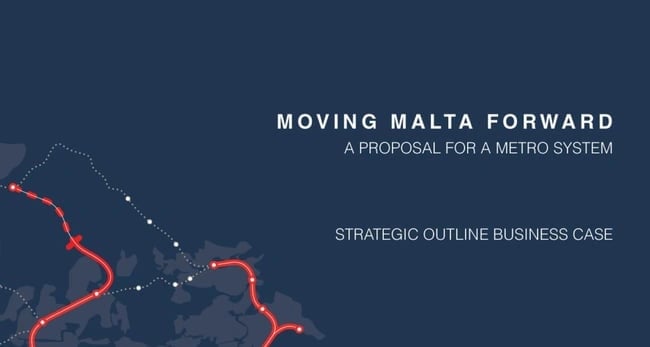
This compelling presentation proposes a metro system for the city of Malta. It opens with a “Case for Change” and uses graphics and visuals to argue for the creation of a metro in the city. While it is text heavy, it includes plenty of information for Malta’s government to make a decision. That’s why it’s important to know your audience. If you’re proposing to a gubernatorial entity, then being comprehensive is important.
2. The Big Picture
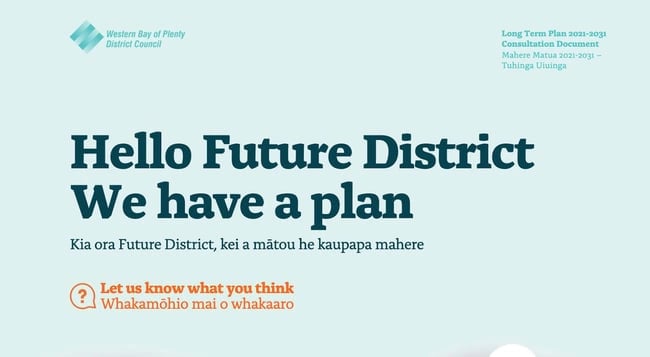
This is another presentation that argues for the urban development of a district. Its most notable feature is its “At a glance” spread, which shows an overview of the plan from top to bottom, down to the impact the proposed changes will have on the city. In the same way, you can include at an at-a-glance slide in your presentation.
3. AMW Tech

This deck presents a business as opposed to a product, but it does everything right: It opens with an agenda and closes with a call-to-action (“Keep in touch with us”). Even something as simple as providing your contact information can be enough to prompt your customer to continue the conversation.
4. Microsoft Advertising

This deck by Microsoft Advertising takes a slightly different approach: It starts with a quote from the Microsoft CEO, and then provides details about how the brand helps its customers. This works for a major brand like this one because the client may be interested in Microsoft as a whole as opposed to just one service. It’s important to know your audience in this respect, as well.
Creating a Compelling Business Proposal Presentation
Being able to effectively present proposals is key to your success. To be effective, get to the point and focus on vision and stories. Use PowerPoint or Keynote as supporting material and be sure to keep it short. Finally, your presentation should begin with compelling reasons to consider your proposal and culminate with a specific request for the business.
Editor's note: This post was originally published in July 2014 and has been updated for comprehensiveness.
Don't forget to share this post!
Related articles.
![project proposal presentation tips What is a Marketing Proposal, and How Can You Create One? [Template Included]](https://blog.hubspot.com/hubfs/marketing%20proposals-1.jpg)
What is a Marketing Proposal, and How Can You Create One? [Template Included]

The RFP Response Formula That Gets an 80% Close Rate

15 Proposal Software Tools for Proposal Creation and Management

7 Things to Consider Before Issuing Your Next RFP

How to Get Paid for Proposals

Why RFPs Fail When Choosing a Marketing Agency

Should You Respond to That RFP? 4 Reasons For Saying 'Yes'

4 Tips For Presenting Powerful New Business Proposals
![project proposal presentation tips Bidsketch Gives Agencies the Tools to Create Proposals — Fast [Tech Profile]](https://blog.hubspot.com/hs-fs/hub/53/file-1520221479-jpg/blog-files/ruben.jpg)
Bidsketch Gives Agencies the Tools to Create Proposals — Fast [Tech Profile]

5 Things Every Marketer Needs to Include in a RFP
Propose your business as the ideal solution using this free template.
Marketing software that helps you drive revenue, save time and resources, and measure and optimize your investments — all on one easy-to-use platform
.css-s5s6ko{margin-right:42px;color:#F5F4F3;}@media (max-width: 1120px){.css-s5s6ko{margin-right:12px;}} Join us: Learn how to build a trusted AI strategy to support your company's intelligent transformation, featuring Forrester .css-1ixh9fn{display:inline-block;}@media (max-width: 480px){.css-1ixh9fn{display:block;margin-top:12px;}} .css-1uaoevr-heading-6{font-size:14px;line-height:24px;font-weight:500;-webkit-text-decoration:underline;text-decoration:underline;color:#F5F4F3;}.css-1uaoevr-heading-6:hover{color:#F5F4F3;} .css-ora5nu-heading-6{display:-webkit-box;display:-webkit-flex;display:-ms-flexbox;display:flex;-webkit-align-items:center;-webkit-box-align:center;-ms-flex-align:center;align-items:center;-webkit-box-pack:start;-ms-flex-pack:start;-webkit-justify-content:flex-start;justify-content:flex-start;color:#0D0E10;-webkit-transition:all 0.3s;transition:all 0.3s;position:relative;font-size:16px;line-height:28px;padding:0;font-size:14px;line-height:24px;font-weight:500;-webkit-text-decoration:underline;text-decoration:underline;color:#F5F4F3;}.css-ora5nu-heading-6:hover{border-bottom:0;color:#CD4848;}.css-ora5nu-heading-6:hover path{fill:#CD4848;}.css-ora5nu-heading-6:hover div{border-color:#CD4848;}.css-ora5nu-heading-6:hover div:before{border-left-color:#CD4848;}.css-ora5nu-heading-6:active{border-bottom:0;background-color:#EBE8E8;color:#0D0E10;}.css-ora5nu-heading-6:active path{fill:#0D0E10;}.css-ora5nu-heading-6:active div{border-color:#0D0E10;}.css-ora5nu-heading-6:active div:before{border-left-color:#0D0E10;}.css-ora5nu-heading-6:hover{color:#F5F4F3;} Register now .css-1k6cidy{width:11px;height:11px;margin-left:8px;}.css-1k6cidy path{fill:currentColor;}
- Project planning |
- 6 steps for writing a persuasive projec ...
6 steps for writing a persuasive project proposal

A project proposal is a written document outlining everything stakeholders should know about a project, including the timeline, budget, objectives, and goals. Your project proposal should summarize your project details and sell your idea so stakeholders buy in to the initiative. In this guide, we’ll teach you how to write a project proposal so you can win approval and succeed at work.
All projects have creation stories, but they don’t start with someone declaring, “Let there be resources!” To move forward with a project, teams must submit a proposal to decision-makers within their organization or to external stakeholders.
What is a project proposal?
A project proposal is a written document outlining everything stakeholders should know about a project, including the timeline, budget, objectives , and goals. Your project proposal should summarize your project details and sell your idea so stakeholders feel inclined to get involved in the initiative.
![project proposal presentation tips [inline illustration] What is a project proposal? (infographic)](https://assets.asana.biz/transform/c2b04f48-8d95-4e09-aa12-e7d5e0b8c89c/inline-project-planning-how-to-write-a-proposal-for-a-project-1-2x?io=transform:fill,width:2560&format=webp)
The goal of your project proposal is to:
Secure external funding
Allocate company resources to your project
Gain stakeholder buy-in
Build momentum and excitement
Project proposals vs. project charters vs. business cases
Project proposals and project charters serve different purposes in the project creation process, and it’s important to understand the difference between the two. While a project proposal takes place in the initiation phase of the project, the project charter takes place in the planning phase.
As mentioned above, a project proposal is a persuasive document meant to convince stakeholders why the project should be carried out. A project charter is a reference document that defines project objectives, and it can’t be created until the project proposal is approved.
People also confuse the business case with the project proposal, but the business case also comes after the proposal. Once the project is approved through a proposal, a business case may be used to secure additional funding for the project.
Types of project proposals
There are six types of proposals you may encounter as a project manager, and understanding the different formats can be useful as you write yours. Each type has a different goal.
![project proposal presentation tips [inline illustration] Types of project proposals (infographic)](https://assets.asana.biz/transform/b89609ec-25cf-4fa6-a4af-0688f71a4ed6/inline-project-planning-how-to-write-a-proposal-for-a-project-3-2x?io=transform:fill,width:2560&format=webp)
Solicited: You’ll send solicited proposals in response to a Request for Proposal (RFP). An RFP announces a project in detail and asks for bids from qualified teams. Because you’re competing against other companies for this type of proposal, you must do thorough research and write persuasively.
Unsolicited: You’ll send unsolicited proposals without an RFP, meaning no one asked for your proposal. In this case, you won’t be up against other companies or teams, but you’ll still need to be persuasive because you have no knowledge of whether the stakeholder you’re pitching to needs you.
Informal: You may have a client send you an informal request for a project proposal, in which case you can respond with your project pitch. Because this isn’t an official RFP, the rules are less concrete.
Renewal: You’ll send renewals to existing clients in hopes that they’ll extend their services with your organization. In this type of project proposal, the goal is to emphasize past results your team has produced for the client and persuade them you can produce future results.
Continuation: You’ll send continuations as a reminder to a stakeholder letting them know the project is beginning. In this project proposal, you’ll simply provide information about the project instead of persuading the stakeholder.
Supplemental: Similar to a continuation proposal, you’ll send a supplemental proposal to a stakeholder already involved in your project. In this type of proposal, you’re letting the stakeholder know the project is beginning, while also asking for additional resources. You should persuade the stakeholder to contribute more to the project in this proposal.
The tone of voice and content of your project proposal will differ based on the type of proposal you’re sending. When you know your project goals, you can write your proposal accordingly.
How to write a project proposal
These step-by-step instructions apply to most project proposals, regardless of type. You’ll need to customize your proposal for the intended audience, but this project proposal outline can serve as a reference to ensure you’re including the key components in your document.
![project proposal presentation tips [inline illustration] How to write a project proposal (infographic)](https://assets.asana.biz/transform/ddf5a670-2fa4-4216-ac08-affdd7201741/inline-project-planning-how-to-write-a-proposal-for-a-project-2-2x?io=transform:fill,width:2560&format=webp)
1. Write an executive summary
The executive summary serves as the introduction to your project proposal. Similar to a report abstract or an essay introduction, this section should summarize what’s coming and persuade the stakeholder to continue reading. Depending on the complexity of your project, your executive summary may be one paragraph or a few paragraphs.
Your executive summary should include:
The problem your project plans to solve
The solution your project provides for that problem
The impact your project will have
You should only address these items briefly in your executive summary because you’ll discuss these topics in more detail later in your proposal.
2. Explain the project background
In this section, you’ll go into the background of the project. Use references and statistics to convince your reader that the problem you’re addressing is worthwhile.
Some questions to include are:
What is the problem your project addresses?
What is already known about this problem?
Who has addressed this problem before/what research is there?
Why is past research insufficient at addressing this problem?
You can also use this section to explain how the problem you hope to solve directly relates to your organization.
3. Present a solution
You just presented a problem in the project background section, so the next logical step in proposal writing is to present a solution. This section is your opportunity to outline your project approach in greater detail.
Some items to include are:
Your vision statement for the project
Your project schedule , including important milestones
Project team roles and responsibilities
A risk register showing how you’ll mitigate risk
The project deliverables
Reporting tools you’ll use throughout the project
You may not have all these items in your proposal format, but you can decide what to include based on the project scope . This section will likely be the longest and most detailed section of your proposal, as you’ll discuss everything involved in achieving your proposed solution.
4. Define project deliverables and goals
Defining your project deliverables is a crucial step in writing your project proposal. Stakeholders want to know what you’re going to produce at the end of your project, whether that’s a product, a program, an upgrade in technology, or something else. As the stakeholder reads through your vision, this will be the section where they say, “Aha, this is what they’ll use my resources for.”
When defining your deliverables, you should include:
The end product or final objective of your project
A project timeline for when deliverables will be ready
SMART goals that align with the deliverables you’re producing
While it’s important to show the problem and solution to your project, it’s often easier for stakeholders to visualize the project when you can define the deliverables.
5. List what resources you need
Now that you’ve outlined your problem, approach, solution, and deliverables, you can go into detail about what resources you need to accomplish your initiative.
In this section, you’ll include:
Project budget : The project budget involves everything from the supplies you’ll need to create a product to ad pricing and team salaries. You should include any budget items you need to deliver the project here.
Breakdown of costs: This section should include research on why you need specific resources for your project; that way, stakeholders can understand what their buy-in is being used for. This breakdown can also help you mitigate unexpected costs.
Resource allocation plan : You should include an overview of your resource allocation plan outlining where you plan to use the specific resources you need. For example, if you determine you need $50,000 to complete the project, do you plan to allocate this money to salaries, technology, materials, etc.
Hopefully, by this point in the proposal, you’ve convinced the stakeholders to get on board with your proposed project, which is why saving the required resources for the end of the document is a smart strategic move.
6. State your conclusion
Finally, wrap up your project proposal with a persuasive and confident conclusion. Like the executive summary, the conclusion should briefly summarize the problem your project addresses and your solution for solving that problem. You can emphasize the impact of your project in the conclusion but keep this section relevant, just like you would in a traditional essay.
Tips for writing an effective project proposal
Following the steps listed above will ensure your project proposal has all the right elements. But if you want to impress your readers and win their approval, your writing must shine. In addition to the above, a project proposal includes:
Know your audience
As you write your proposal, keep your audience (i.e. the stakeholders) in mind at all times. Remember that the goal of the proposal is to win your audience over, not just to present your project details. For example, if you’re creating a new editing tool for a children’s publishing house, can you determine whether your stakeholders are parents and appeal to their emotional side when persuading them to buy in to your product?
Be persuasive
Persuasion is important in a project proposal because you’re hoping your audience will read your proposal and do something for you in return. If your reader isn’t intrigued by your project, they won’t feel inclined to help you. If you describe your editing tool but don’t mention the many features it will offer, how it will benefit clients, and its positive impact in the industry, your audience will wonder, “Why should I care about this project?”
Keep it simple
While you should go into detail on your problem, approach, and solution, you shouldn’t make your project proposal overly complex. This means you can discuss the project plan for your proposed editing tool without discussing what codes the engineers will use to make each feature work.
Do your research
A successful project proposal includes thorough research. Be prepared to back up your problem—and solution—with reputable sources, case studies, statistics, or charts so you don’t leave your audience with questions. When writing your proposal, put yourself in the reader’s shoes and ask:
Why is this a problem?
How is this a solution to the problem?
Has anyone addressed this problem before?
What are the project costs?
If you can answer these questions, then you’ve likely done enough research to support your proposed initiative.
Use project management tools to strengthen your project proposal
Good project proposals require team collaboration . With the right management tools, your team can communicate, share information, and work together on one shared document.
When you store all your project information in one place, it’s easy to access that data when you need it. Project proposals stem from well-organized and properly planned projects, which is why project management software is a key resource to effectively write a project proposal. Ready to get started? Try Asana .
Related resources

Unmanaged business goals don’t work. Here’s what does.

How Asana uses work management to drive product development

How Asana uses work management to streamline project intake processes

How Asana uses work management for smoother creative production
- PRO Courses Guides New Tech Help Pro Expert Videos About wikiHow Pro Upgrade Sign In
- EDIT Edit this Article
- EXPLORE Tech Help Pro About Us Random Article Quizzes Request a New Article Community Dashboard This Or That Game Popular Categories Arts and Entertainment Artwork Books Movies Computers and Electronics Computers Phone Skills Technology Hacks Health Men's Health Mental Health Women's Health Relationships Dating Love Relationship Issues Hobbies and Crafts Crafts Drawing Games Education & Communication Communication Skills Personal Development Studying Personal Care and Style Fashion Hair Care Personal Hygiene Youth Personal Care School Stuff Dating All Categories Arts and Entertainment Finance and Business Home and Garden Relationship Quizzes Cars & Other Vehicles Food and Entertaining Personal Care and Style Sports and Fitness Computers and Electronics Health Pets and Animals Travel Education & Communication Hobbies and Crafts Philosophy and Religion Work World Family Life Holidays and Traditions Relationships Youth
- Browse Articles
- Learn Something New
- Quizzes Hot
- This Or That Game New
- Train Your Brain
- Explore More
- Support wikiHow
- About wikiHow
- Log in / Sign up
- Finance and Business
- Running a Business
How to Present a Proposal
Last Updated: February 22, 2024 Approved
This article was co-authored by Michael McCutcheon, PhD . Dr. Michael McCutcheon is a career coach, psychologist, and award-winning public speaker who specializes in procrastination elimination, goal achievement, and increasing life satisfaction. With a background as a counseling psychologist, he guides clients toward becoming more aware of their desires and anxieties to break old patterns, create new habits, and achieve life-changing results. He also helps clients improve organization skills, embark on a new career, get promoted, get admitted into graduate schools, and transition from school to the working world. He is a published author and lecturer in graduate psychology courses at New York University (NYU), a position he has twice won the Teaching Award (2014 & 2019). His work has appeared in the press as a lifestyle and career expert for The Washington Post/The Associated Press, The New York Post, Scholastic, Lifehacker, and The Coca-Cola Company. He has served as a contributing writer for Out Magazine and featured panelist on National Public Radio (NPR). There are 7 references cited in this article, which can be found at the bottom of the page. wikiHow marks an article as reader-approved once it receives enough positive feedback. In this case, 100% of readers who voted found the article helpful, earning it our reader-approved status. This article has been viewed 55,424 times.
Presenting a business proposal requires more than simply reading a transcript of the proposal text. Gaining the confidence of your audience requires tact, research, and a whole lot of preparation. If done correctly, your presentation can inspire your listeners to adopt your proposal.
Preparing the Proposal

- If possible, talk to someone who has already seen the proposal, and gauge their interest.
- Check recent news stories which indicate the current financial state of the company or individual you're targeting.
- Think about the audience's values, goals, and ideals. Your proposal should address not just their economic needs but their corporate mission, too.

- Your written proposal should not be identical to your oral presentation. Simply reading the proposal word for word will bore your audience. Your oral presentation should use the proposal text as a foundation but should also expand on your main points without lingering on every detail.

- An improper or incomplete proposal submission may jeopardize your chances of not only having your proposal approved but also receiving future RFPs. Use care when crafting your submission.

Making the Pitch

- This is especially important when conducting an RFP presentation.

- Slide shows can help listeners retain information and better understand the main points of your proposal.
- You can use the slide show to supplement or replace your own notes. They can keep you on track and keep your audience engaged.

- Before you begin, try breathing in and out slowly for a while.
- Assume your audience is receptive, not hostile, to your proposal.

- Avoid interjecting filler words like "uh" or "um" into your presentation.

Sealing the Deal

- If you get an off-topic or difficult question, address it honestly, but artfully try to redirect the question back to why your proposal is a good one. [11] X Trustworthy Source Harvard Business Review Online and print journal covering topics related to business management practices Go to source

Expert Q&A

- Don't feel defeated if your proposal is not accepted. Think of it as a learning experience, and try to identify points which could be stronger next time. Thanks Helpful 0 Not Helpful 0
- Pay attention to the details. This applies to both the written proposal and your oral presentation. Thanks Helpful 0 Not Helpful 0
- Dress professionally for your presentation. First impressions are important. A sloppy appearance could hurt your proposal's chances of success no matter how good your presentation is. Thanks Helpful 0 Not Helpful 0

- Do not take beta-blocker drugs in an attempt to relax before your presentation. You run the risk of becoming a little too relaxed and doing or saying something you'll later regret. Thanks Helpful 1 Not Helpful 0
You Might Also Like

- ↑ Michael McCutcheon, PhD. Career Coach & Psychologist. Expert Interview. 14 October 2020.
- ↑ https://www.entrepreneur.com/starting-a-business/7-steps-to-a-winning-business-proposal/299681
- ↑ http://www.fripp.com/selling-your-way-to-success-how-to-present-your-proposal-at-an-executive-meeting/
- ↑ Paul R. Timm, How to Make Winning Presentations, https://books.google.com/books?id=qqScv8LU9noC&lpg=PP1&dq=winning%20presentations&pg=PT60#v=onepage&q=winning%20presentations&f=false
- ↑ Thomas Leech, How to Prepare, Stage, and Deliver Winning Presentations, https://books.google.com/books?id=GEJn-UPf1cEC&lpg=PP1&dq=winning%20presentations&pg=PA80#v=onepage&q=proposal&f=false
- ↑ https://hbr.org/2010/11/how-to-get-their-approval.html
- ↑ https://hbr.org/2010/11/defend-your-research-people-often-trust-eloquence-more-than-honesty/ar/1
About This Article

To present a business proposal, make sure to speak in a clear, audible voice to command your audience’s attention, and avoid using distracting filler words like “uh” and “um.” Additionally, emphasize the main points rather than reading your proposal word for word, since your audience will have the text before them. You should also use visuals, like PowerPoint slide shows, to help the audience have a better understanding of your main points. Then, end your proposal by reiterating your main points in a simple, straightforward way. For more advice, like how to write your proposal with inspiring, optimistic language, keep reading! Did this summary help you? Yes No
- Send fan mail to authors
Reader Success Stories
Kudzie Brown
Jan 3, 2018
Did this article help you?
Jul 1, 2017
Jun 30, 2018

Featured Articles

Trending Articles

Watch Articles

- Terms of Use
- Privacy Policy
- Do Not Sell or Share My Info
- Not Selling Info
Get all the best how-tos!
Sign up for wikiHow's weekly email newsletter
- SUGGESTED TOPICS
- The Magazine
- Newsletters
- Managing Yourself
- Managing Teams
- Work-life Balance
- The Big Idea
- Data & Visuals
- Reading Lists
- Case Selections
- HBR Learning
- Topic Feeds
- Account Settings
- Email Preferences
What It Takes to Give a Great Presentation
- Carmine Gallo

Five tips to set yourself apart.
Never underestimate the power of great communication. It can help you land the job of your dreams, attract investors to back your idea, or elevate your stature within your organization. But while there are plenty of good speakers in the world, you can set yourself apart out by being the person who can deliver something great over and over. Here are a few tips for business professionals who want to move from being good speakers to great ones: be concise (the fewer words, the better); never use bullet points (photos and images paired together are more memorable); don’t underestimate the power of your voice (raise and lower it for emphasis); give your audience something extra (unexpected moments will grab their attention); rehearse (the best speakers are the best because they practice — a lot).
I was sitting across the table from a Silicon Valley CEO who had pioneered a technology that touches many of our lives — the flash memory that stores data on smartphones, digital cameras, and computers. He was a frequent guest on CNBC and had been delivering business presentations for at least 20 years before we met. And yet, the CEO wanted to sharpen his public speaking skills.
- Carmine Gallo is a Harvard University instructor, keynote speaker, and author of 10 books translated into 40 languages. Gallo is the author of The Bezos Blueprint: Communication Secrets of the World’s Greatest Salesman (St. Martin’s Press).
Partner Center
Kantata Blog
IN THE NEWS
Total Economic Impact Study Reveals Kantata Provided $24.5 Million in Benefits to Services Organizations
- Agency & Marketing
- Business Intelligence
- Client Engagement
- Growth and Profitability
- Industry Perspectives
- Operational Efficiency
- Professional Services Technology
- Project Management
- Resource Management
- Workforce Trends
- In The News
- Success Stories
- Women In Tech

8 Tips for Writing a Project Proposal
Updated jul 12, 2022.
The first step of writing an effective project proposal is to remember you’re not writing a contract and not writing a summary document; you’re writing a sales document that is meant to persuade the client that you’re the right choice to complete the work.
Once your project proposal is complete, you should have shown that you understand the goals and objectives of the project, described how you are going to execute the project, explained the outcomes your client should expect, and described how and why they should choose you or your company to complete the project.
Below are 8 tips that will help you write a better, more effective project proposal.
1. Understand What the Client is Looking For
Your project proposal is a presentation of your capabilities to execute the outcomes desired by the client or company. In order to write a good quality project proposal, you need to start with a complete understanding of why the client or company is seeking to complete the project, what outcomes they hope to see, in what amount of time they hope the project to be completed, and any specifics about how they would like the project completed.
Nothing can kill a proposal faster than misunderstanding the project and presenting something that’s off the mark. Take the time during the initial consultation to ask questions and understand the project.
2. Know Your Costs
One of the most important factors in writing a project proposal is to have clear knowledge of your costs. If you don’t currently have a good tracking system for actual project costs and profitability, it may be time to get one. That’s because without a clear tracking system for costs and profits, you may be undercharging or overcharging for projects and may not know it. This improvement in information can have a huge impact not only on the accuracy of your project proposal, but also on the profitability of your project as a whole.
3. Know Your Team’s Capabilities
You should have a good understanding of your team and what they’re capable of accomplishing before you promise outcomes to a client. In a project proposal, it’s also important to know your team’s current workload so you can present an accurate timeline.
Not only will this help you provide a more accurate timeline for the project, but it will also help you see whether any contractors or additional hires will be needed to complete the project.
4. Be Specific
While a project proposal is not a final contractual document, it will serve as the guideline for your client and project stakeholders’ expectations, as well as for how you organize the execution of the project. Remember, you’re proving in this document that you have the knowledge, experience, and resources to get the project done—and get it done well.
It can be helpful to start by drafting a list of the steps you’ll need to take from inception to completion of the project. This can be your outline for the statement of work (SOW). You can choose to take the key pieces or deliverables from this list and add them to the scope of work or project outline, or you can include all the steps. In your project proposal, you will want to expand upon these steps to describe what, exactly, they entail, including:
- Expected deliverables
- Challenges your specific expertise will help overcome
- Predicted timeline for certain steps
- Budget and expected costs
5. Avoid Excessive Jargon
It can be tempting to throw in acronyms or other technical jargon to prove you are an expert in your industry, but in many cases too much jargon can be detrimental to your project proposal. Jargon can make your audience feel like you’re talking over their heads, making them feel alienated or decreasing trust. If you’re not sure whether the decision-maker is savvy with your technical terms, tone the jargon down and add more inclusive descriptions that can be understood by a wider range of readers.
6. Include Persuasive Proof
Don’t forget that your client is likely receiving multiple project proposals. This means they’re not only looking for a breakdown of what the project would look like in your hands; they’re also looking for proof that you can do what you say you’re going to do. A good addition is to include persuasive elements such as positive reviews, case studies, “before and after” photos, descriptions of work provided, statistics, and other supplemental documents that prove that you’re well qualified for the work.
7. Provide a Call to Action
Any sales or marketing professional will tell you that it’s important to guide a potential customer to the “next step” toward closing instead of hoping they’ll figure it out on their own. This can be as simple as adding a “next steps” section to your project proposal that includes a description of what moving forward would look like. This might include a preliminary planning meeting, drafting and approving a contract, an onboarding call, and dissemination of information to support the project. You should consider this as a way to guide the decision-makers to the finish line.
8. Include Your Contact Information
This one goes without saying, but it’s also one that is often accidentally overlooked. You should make sure your project proposal always includes your contact and company information. There should never be a point where your client is reading the proposal and wondering, “Which company is this from, again?” This information can be included in the header of your document, in the footer of every page, and on the final page of the proposal.
Want to learn more about project proposals?
Learn to write the ultimate project proposal with sample outlines, formats, and a template to get you started.
Why Kantata?
Click here to discover how The Kantata Professional Services Cloud takes project management to a new level with purpose-built cloud software created specifically to solve the challenges faced by services organizations.
Recommended for you
5 steps to more profitable projects, the pmo: winning the talent war and adapting to the new normal, the technology imperative for professional services consolidate with the full project lifecycle in mind, project management success factors: common failures & how to avoid them, subscribe to get updates.
How to Present Your Business Proposal & Win Clients: 11 Helpful Tips
Introduction.
The day has come. You've started a new business, and your customers are increasing. Even if you're making progress, you get the impression that you might be doing better.
There's a universe of untapped potential all around you – prospects that you know might benefit from your product or service. And the challenges you're encountering are less about the soundness of your solution and more about how you might reach your potential base.
Presenting your business plan to customers is the climax of a lengthy sales process. You most likely spent a significant amount of time preparing your business proposal presentation, but the prospect of delivering it could be frightening. This article will undoubtedly assist you in presenting your business proposal in an efficient and successful manner.
What is a business proposal?
A business proposal is a formal document that a company creates and sends to a prospect in order to achieve a business deal.
A common misconception is that business proposals and business plans are identical. The purpose of a good business proposal is to sell your product or service, not your business. Rather than supporting you in your hunt for investors to finance your business, a proposal assists you in your search for new clients.
📌 Related resource: 5 Free Business Plan Templates to Simplify Your Planning Process
How to successfully present business proposals to clients
1. start straight from the point.
Your customers are busy, so don't waste their time by starting with an introduction about yourself or your organization. Their most valuable asset is time, and they don't want to squander it by listening to your story. So, never mess with the projector, never come late, and avoid anything that gives the impression that you don't value their time.
Begin by addressing the major issue of your proposal; ideally, do it within the first minute of your speech. Because there is a considerable probability that your audience will want to ask you questions, it is best to address the major topic right away.
2. Ask questions in between
After a few minutes of speaking, break the monotony by asking your customers some informative questions. If they've lost interest in your business proposal, these questions will pique their attention again.
Here are a few examples of questions you might ask your audience to keep them interested:
- How would you describe success if someone asked you, "What is success to you?"
- Have you ever used this strategy before? If so, then when?
- Is this your company's most significant challenge?
3. Leverage visuals
Add graphics to your business proposal to attract more attention; using images when presenting business proposals can captivate the audience's attention more effectively than merely using words. Including graphics in your business proposal presentation will increase its impact.
However, knowing which images to use in your business proposal is equally critical. Not every picture is effective. Charts and graphs may be tedious, and they may distract rather than engage your viewers. As a result, do a lot of thinking and choose your photographs wisely.
Identify images that will impact, or take advantage of tools like Scribe to showcase processes — complete with written steps and annotated screenshots.
{{banner-default="/banner-ads"}}
It's a fast and easy way to illustrate exactly how to use your product. Here's an example of Scribe in action (that only took 15 seconds to make).
4. Sell your vision
Clients hate speakers who constantly talk about their firm and themselves. Remember that they are there to see whether you can assist them, not simply to listen to your stories. They are more interested in learning how to outperform their competition, get new clients, retain existing ones, and quadruple their earnings.
So, instead of delivering uninteresting statistics and data while presenting your business plan, sell your company's vision by proposing answers to these difficulties.
5. Keep a clear agenda in mind
A good business proposal presentation is all about engaging them and demonstrating why you are their best option. This is why you should have a clear and engaging objective for your business proposal. When you make your company proposal, you should start with arguments that urge the customer to think about it and conclude with them approving it.
- Opportunity: Begin your business proposal presentation by describing the opportunities or difficulties that your customers are missing. Make it as interesting as possible so that your audience looks forward to seeing the rest of your presentation.
- Benefits: State the advantages that your customers will get if they listen to the full presentation.
- Plan: Display the strategy you designed to tackle the client's challenges.
- Introduce your company: Explain briefly your company's origins, history, and so forth.
- Recommend: Finish your business proposal presentation by inviting the customer to conduct business with you.
6. Address common customer problems
Start the meeting with a challenge or an opportunity. Don't enter into a meeting and start talking about yourself, your company, or your products right away. If you do this, your customer will quickly focus on price and product characteristics, frequently ending the meeting before you've finished.
Instead, emphasize the customer's difficulties and pain areas. Your customers want to know how they can outperform their competition, reach new consumers, retain current customers, and boost profit margins.
But, before you can offer them your solution, you must underline the severity of the problem and demonstrate how their obstacles will prohibit them from accomplishing their objectives.
7. Inject stories in your presentation
Since our brains are built to comprehend the information provided in a story, thus storytelling makes it easier for your audience to grasp your business proposal presentation.
People used to communicate news and attempt to explain natural events such as lightning, rain, and even the seasons. We're still doing it decades later. Whether you're telling the latest news to a close friend or your boss about how the presentation went, you're definitely going to be telling a story.
Incorporating stories also makes your business presentation 100 times more memorable to your audience. This is critical because important decision-makers will only examine proposals that have made an indelible impression on them.
8. Let your stories lead
While customers appreciate facts and numbers, they are as interested in learning about what the statistics and figures cannot tell them. Stats are vital in a business presentation , but telling a story can help you attract the attention of your audience.
Begin with a story that is supported by facts and research that you have conducted. The story can be extremely basic; for example, you can describe your customers' demands and skillfully portray them in the story. If you include an emotional appeal in your pitch, it will become much more powerful.
9. Don't simply start reading your slides
Let your presentation deck replenish your points. You'll immediately bore your customer if you read directly from the slides, and the significance of what you're saying will be lost.
Keep your slides simple as well, so you're not tempted to read from them. Most presentations are far too complicated, with excessive text, confusing designs, and scattered graphics.
A slide should only include one image and one line of text. No more. Your consumers can only take so much information at once, and if they're too preoccupied with sorting through paragraphs upon paragraphs on the screen, they'll miss much of what you'll say.
10. Leverage presentation templates
Standard PowerPoint templates have become something of a cliché, and they could weaken the overall effect of your presentation. If you want to seem professional, you must go beyond PowerPoint.
SlideUpLift has a large collection of free PowerPoint templates , and Google Slides Templates that you can rapidly change to fit your brand and use for your company proposal presentation.
11. Set up a clear follow-up timeline as the meeting ends
This is possibly the most crucial aspect of your business proposal presentation. Tell your consumer what will happen after the presentation, so there is no confusion regarding the subsequent steps.
Share a clear follow-up date and set a timeline. For example, you may claim you'll call on a specific day and then deliver the contract. Your contract will be in your client's hands for a week, after which you will follow up on the following Wednesday to see if the consumer has any questions.
This timeline should be adjusted based on your customer, sales cycle duration, and industry. A product that costs thousands of dollars and demands a yearlong commitment may not be appropriate for such a short timetable. However, it can be appropriate for a product that only costs a few hundred dollars per year.
Wrapping up on how to present business proposals
Your business proposal features will differ depending on the demands of the prospect and the type of company you're in. Prospective consumers should have very few questions about your organization and what it can achieve for them after going through your strategy.
The ability to present a company proposal effectively is critical to your success. By following these eleven recommendations, you will be able to present your business proposal in such a manner that your customers will enjoy it, and you will gain more business.
Ready to try Scribe?
Related content
- Scribe Gallery
- Help Center
- What's New
- Careers We're Hiring!
- Contact Sales
Got any suggestions?
We want to hear from you! Send us a message and help improve Slidesgo
Top searches
Trending searches

palm sunday
5 templates

14 templates

solar eclipse
25 templates

26 templates

28 templates

13 templates
Design Inspiration Project Proposal
Design inspiration project proposal presentation, free google slides theme and powerpoint template.
Download the "Design Inspiration Project Proposal" presentation for PowerPoint or Google Slides. A well-crafted proposal can be the key factor in determining the success of your project. It's an opportunity to showcase your ideas, objectives, and plans in a clear and concise manner, and to convince others to invest their time, resources, and support in your vision. Think of it as your chance to make a case for your project and to motivate others to join you on your journey. Well, that journey begins here, with our editable template for Google Slides and PowerPoint presentations. Download it and start working on your proposal.
Features of this template
- 100% editable and easy to modify
- Different slides to impress your audience
- Contains easy-to-edit graphics such as graphs, maps, tables, timelines and mockups
- Includes 500+ icons and Flaticon’s extension for customizing your slides
- Designed to be used in Google Slides and Microsoft PowerPoint
- Includes information about fonts, colors, and credits of the resources used
How can I use the template?
Am I free to use the templates?
How to attribute?
Attribution required If you are a free user, you must attribute Slidesgo by keeping the slide where the credits appear. How to attribute?
Related posts on our blog.

How to Add, Duplicate, Move, Delete or Hide Slides in Google Slides

How to Change Layouts in PowerPoint

How to Change the Slide Size in Google Slides
Related presentations.

Premium template
Unlock this template and gain unlimited access

Register for free and start editing online

IMAGES
VIDEO
COMMENTS
Here is a project proposal example structure using project proposal templates to help you get started on your presentation. Slide 1: Cover Slide with Project Name Like in all presentations, you don't dive into the main part of the presentation without introducing the name of the project and yourself as presenter.
The proponents create a solicited project proposal presentation detailing their approach, expertise, timelines, and costs for addressing the outlined needs. Organizations evaluate and compare the proposals that describe their solutions and services before selecting them. 2. Unsolicited Project Proposal.
3. Use Visuals. Charts, graphs, and infographics communicate the profitability and feasibility of your project proposal at best. The majority of people are visual learners, so neglecting this approach is decreasing the impact you could cause. Besides, choose a design for the project proposal presentation.
Here is the complete list of steps you should follow to write a project proposal that will bring results. 1. Preparing for the Writing. Proper research is the unsung hero of any successful proposal. It may be one of the invisible parts of the process, but it is one of the most important.
Six steps to writing a project proposal: write the executive summary, explain the project background, present a solution, and define the project deliverables and resources needed. Top tips for writing a persuasive project proposal: know your audience, keep it simple and make it persuasive, do you research, use a template and cover letter.
No matter the purpose, proposal presentations require proposal teams and sales to align. Here are 6 tips for your next proposal presentation: 1. Define Your Agenda. Prospective clients and investors frequently ask for a presentation post-proposal submissions. Most often, they need to gain a better understanding of the proposal.
Here's a step-by-step guide to writing a persuasive priority proposal. 1. Write an Executive Summary. The executive summary provides a quick overview of the main elements of your project proposal, such as your project background, project objectives and project deliverables, among other things.
2 Lay Out Your Project Plan. Once you've set your goals, the next big step is to outline how you'll achieve them. An excellent place to start is by organizing your project into an actionable plan and steps for execution. You might wonder why this step is important for creating a successful project presentation.
Add a great case study. Once you've presented your solution and price, it might be a good idea to quickly present a few case studies. They will show how you helped a client in a similar position before. It will be a good way to win over the audience, especially if you think you've lost them after presenting your price.
2. Have a clear agenda. Your presentation must have a clear and compelling agenda, which you can share right at the start (in addition to having shared it over email before the meeting). The meeting should begin with compelling reasons to consider your proposal and culminate with a specific request for the business.
For startups and small businesses, a sales project proposal can replace lengthy presentations. It's a chance for you to describe the market opportunity, how your service is the solution, and the investment required for growth. ... FREE AI PROJECT PROPOSAL TEMPLATE. Top tips when considering how to write a proposal for a project. Before ...
Your project proposal should summarize your project details and sell your idea so stakeholders feel inclined to get involved in the initiative. The goal of your project proposal is to: Secure external funding. Allocate company resources to your project. Gain stakeholder buy-in. Build momentum and excitement.
3 Plot your presentation with an audience journey map. An audience journey map helps you structure your business proposal presentation. It works very much like creating your buyer's journey in that it takes your prospects—in this case, your audience —down your marketing funnel.
A project the not etwas that just comes common overnight. It often takes strategic planning both a significant amount of time to get i right and receiver the support it needs to thrive.To 6 Steps to Writing a Project Proposal (Examples & Templates) | How to Write a Project Proposal and Present it to Stakeholders - SlideModel
1. Close your presentation with a solid punch. Reiterate your main points in a simple, straightforward way. Make it clear that your proposal is the most advantageous course of action. Use a story, demonstration, or illustration to inspire your audience to take the next step and adopt your proposal. [9] 2.
A project proposal is a written document that describes a project you intend to execute. It usually includes your project's goals, methods, timeline, budget, deliverables, and resource requirements. Depending on the type and the scope of your project, you can choose what to include and what not to include in your proposal.
Section 1: Executive summary. Write an introductory section, called the executive summary, to summarize your project. Just like the introduction of an essay, this section should aim to catch your recipient's attention and encourage them to read on. Your executive summary should include details about the following:
Buy Copies. Never underestimate the power of great communication. It can help you land the job of your dreams, attract investors to back your idea, or elevate your stature within your organization ...
Writing a Project Proposal. 1: Defining the Purpose. 2: Talk About the Solution. 3: Detail the Outcomes and Norms for Success. 4: Plan Resources. 5: Lay Out Your Schedule. 6: Executive Summary. Tips for writing an effective project proposal. Presenting a Project Proposal to Stakeholders.
Below are 8 tips that will help you write a better, more effective project proposal. 1. Understand What the Client is Looking For. Your project proposal is a presentation of your capabilities to execute the outcomes desired by the client or company. In order to write a good quality project proposal, you need to start with a complete ...
Introduce your company: Explain briefly your company's origins, history, and so forth. Recommend: Finish your business proposal presentation by inviting the customer to conduct business with you. 6. Address common customer problems. Start the meeting with a challenge or an opportunity.
Download the Automotive Industry Project Proposal presentation for PowerPoint or Google Slides. A well-crafted proposal can be the key factor in determining the success of your project. It's an opportunity to showcase your ideas, objectives, and plans in a clear and concise manner, and to convince others to invest their... Business. 16:9.
It has a modern and attractive design, so your speech will be in touch with new trends and will look fresh. The slides are also full of resources that you can use to illustrate complicated data or processes in a creative and understandable way. This is the perfect combination that will make your proposal stand out from all the rest.
Download the "Design Inspiration Project Proposal" presentation for PowerPoint or Google Slides. A well-crafted proposal can be the key factor in determining the success of your project. It's an opportunity to showcase your ideas, objectives, and plans in a clear and concise manner, and to convince others to invest their time, resources, and ...